Ultimate 10-Day Austria Itinerary: Best Stops, Maps, Costs & Travel Tips

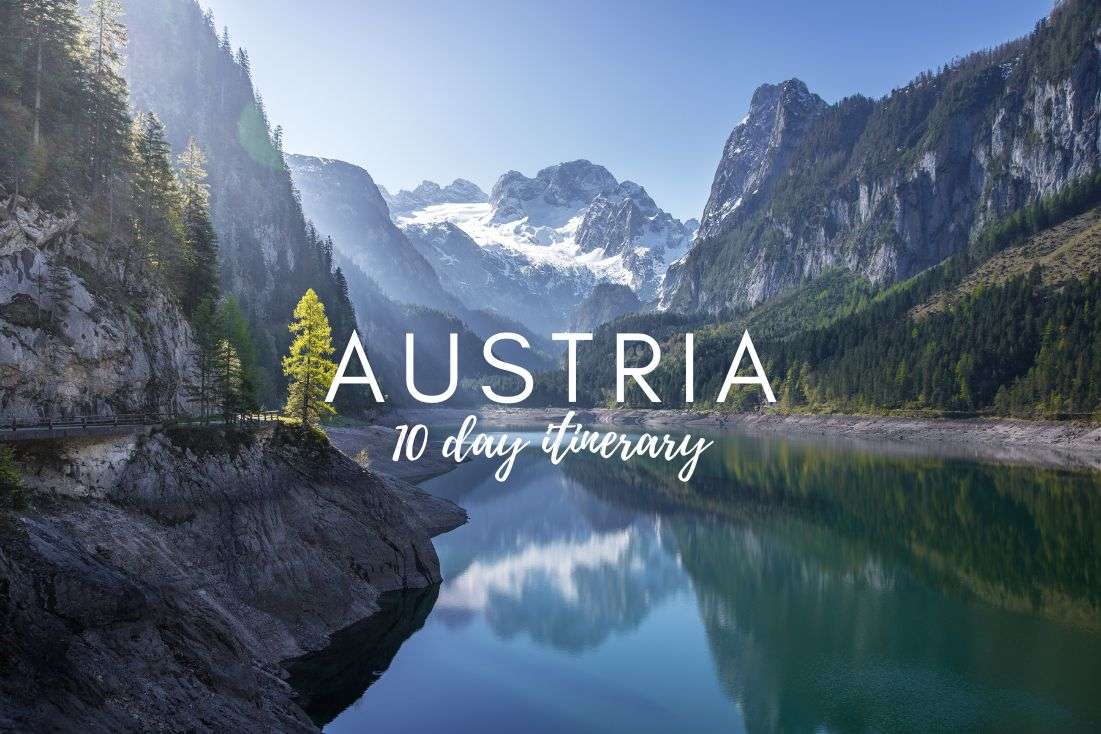
I’m convinced that the best part of Austria is its countryside. The Alps, with their amazing viewpoints, deep gorges, and cool waterfall,s are a huge part of this Austria travel itinerary, though I’ll take you to a handful of towns and cities as well.
You’ll be changing hotels a few times and sleeping in Vienna, Hallstatt, Zell am See, and Innsbruck and using them as a base to explore the incredible surroundings. Here’s how to spend 10 days in Austria:
Austria travel itinerary: Daily Breakdown
This is the itinerary:
Day 1: Vienna (sleep in Vienna)
Day 2: Vienna (sleep in Vienna)
Day 3: Schloss Ort, Salzburg (sleep in Hallstatt)
Day 4: Hallstatt (sleep in Hallstatt)
Day 5: Dachstein (sleep in Hallstatt)
Day 6: Hohenwerfen Castle, Liechtenstein Gorge, Zell am See (sleep in Zell am See)
Day 7: Grossglockner, Zell am See boat tour, Bad Gastein (sleep in Zell am See)
Day 8: Kitzsteinhorn, around Kaprun (sleep in Zell am See)
Day 9: Krimmler Waterfalls, Swarovski Kristallwelten, Innsbruck (sleep in Innsbruck)
Day 10: 007 Elements (Museum of James Bond) (back to Vienna or sleep in Innsbruck)
At the beginning of each day, you’ll find a map, a list of the main stops of the day, my restaurant tips, and some links to my other articles where you can read up on further details.
I’ve also tried to save you a chunk of time by recommending hotels in each city, all from my personal experience.
This Austria itinerary expects you to be renting a car. You can read what I think about driving in Austria at the end of this article.
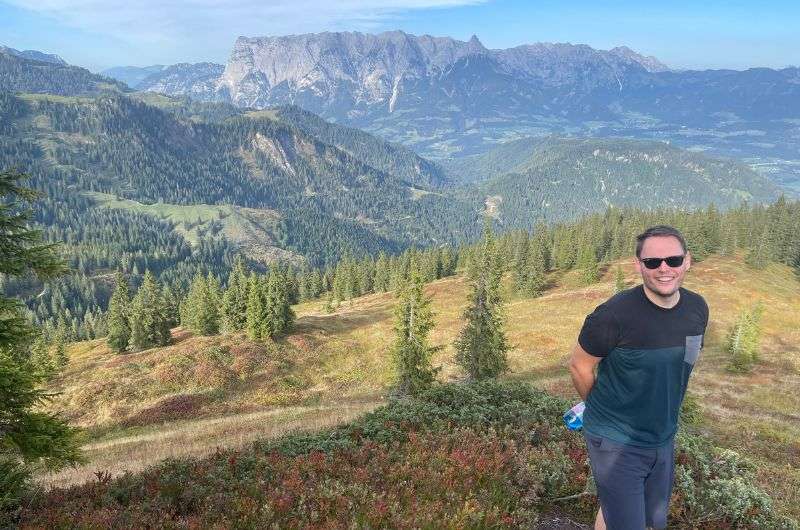
Exploring the breathtaking Austrian mountains—adventure awaits!
Austria itinerary map: The places you’ll see in 10 days
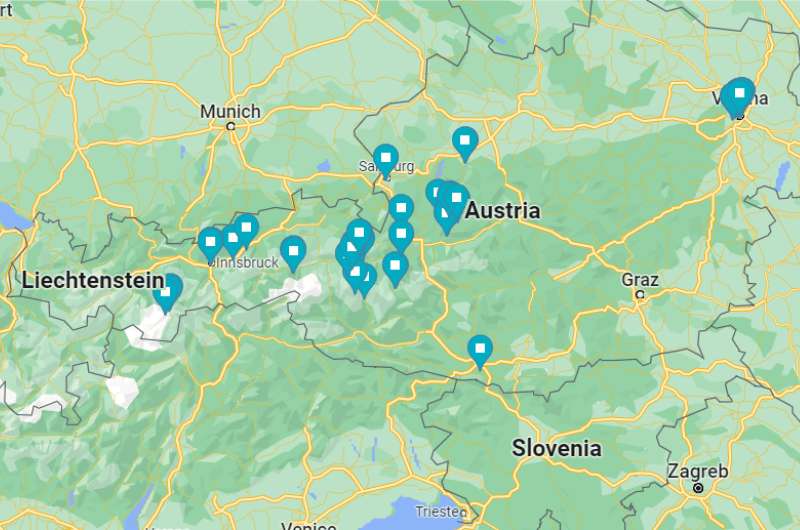
The locations of all the places mentioned on this itinerary.
Day 1 of Austria itinerary: Vienna
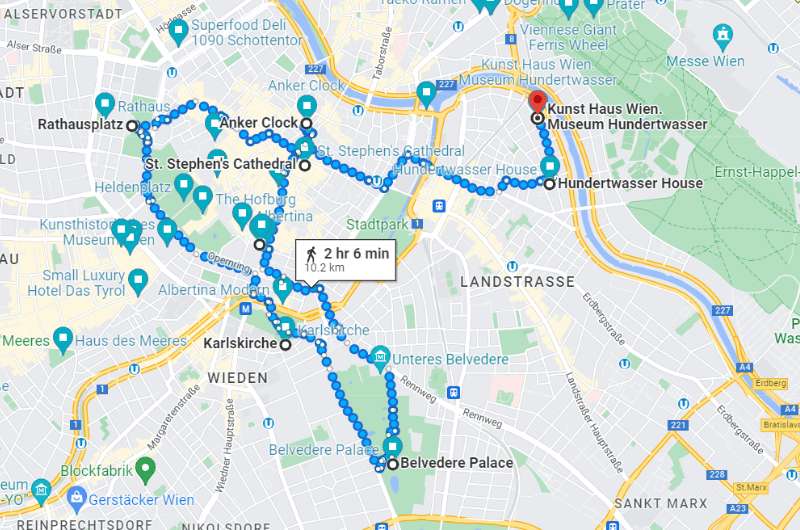
See this map in Google Maps so you can just click and walk
Main sites visited on day 1: Stephansdom, Anker Clock, Cafe Sacher, Belvedere, Karlskirche, Rathausplatz, Hundertwasser House, Kunst Haus Wien
Restaurant tips: KLYO | Superfood Deli | Dogenhof | Taeko Ramen | Café Sacher
Hotel recommendations: Boutiquehotel Das Tyrol
Further reading: Vienna 3 day itinerary
You’ll kick off your Austria trip with a wander around Vienna, the country’s capital. I already have a full Vienna 3 day itinerary written up with extensive details of visiting every single spot, so I will keep it simple here and you can go check out more details in the other article if you need to.
First things first, I thought I needed a place to sleep in Vienna.
Your hotel in Vienna
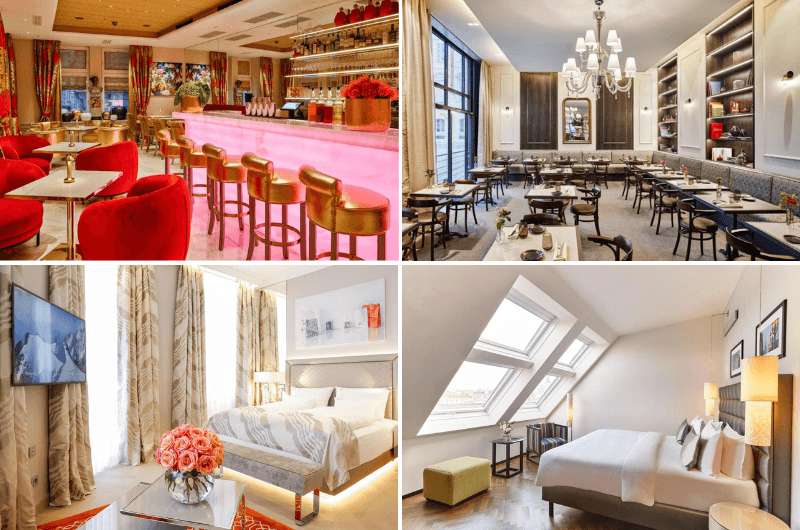
Two options for different styles: Boutique Das Tyrol on the left and Steigenberger Hotel Herrenhof on the right
I’ll give you two tips on places to stay, each different in style, so everyone can choose their favorite.
First is the cheaper of the two, the 4-star Boutiquehotel Das Tyrol. It’ very artsy fartsy—pieces from Vienna’s best designers decorate the interior. It’s located on Mariahilfer Straße shopping street.
The beds in this hotel are uber-comfortable, the staff goes above and beyond, and Prosseco is served with breakfast. Nuff said.
The second hotel is one star more expensive: Steigenberger Hotel Herrenhof, but it’s smack in the middle of Vienna’s center. It has probably the best price/quality/location ratio out of all of Vienna’s hotels.
The rooms in this historical building are pleasantly modern (with AC) and decorated in 21st-century interpretations of various styles.
Two whole floors of the hotel are dedicated to a spa and fitness center. So, instead of artsy fartsy, you can be... working out.
Day 1—Vienna—stop 1: Stephansdom
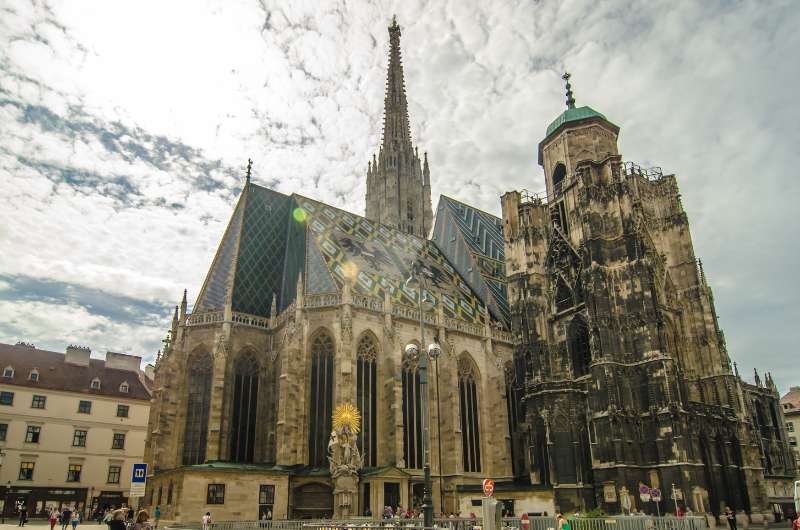
St. Stephen’s Cathedral, aka Stephansdom
Time spent here: 20 minutes to 1.5 hours
Every Vienna visit starts with St. Stephen’s Cathedral (Stephansdom), which stands prominently on Stephansplatz—even a bit too prominently because it takes up the whole square!
You can see the main length and some smaller chapels of the Stephansdom for free, but you do need a ticket to go further into the church and see the altar, for instance.
I recommend at least paying to go up the north tower for the best views of those tiles that are so inconveniently on the rooftop, and also Vienna’s largest bell, the Pummerin.
Another hidden option is touring the catacombs (only with a guide), where you’ll be in the company of the bones of 11,000 people, including some very high-ranking Habsburgs (actually, Stephansdom only has their internal organs, but more about that on the tour).
Tickets can’t be bought online on the official site. Buy tickets at the ticket desk in person, they take cash only!
- Open Monday to Saturday 9 am–11:30 am and 1 pm–4:30 pm, Sundays and public holidays from 1 pm–4:30 pm. Check the website for detailed opening times for each section, though.
- Tickets are EUR 20 for all-inclusive, EUR 6 for a cathedral audio guide, EUR 6 for each of the towers, and the catacomb tour.
Day 1—Vienna—stop 2: Ankeruhr (Anchor Clock)
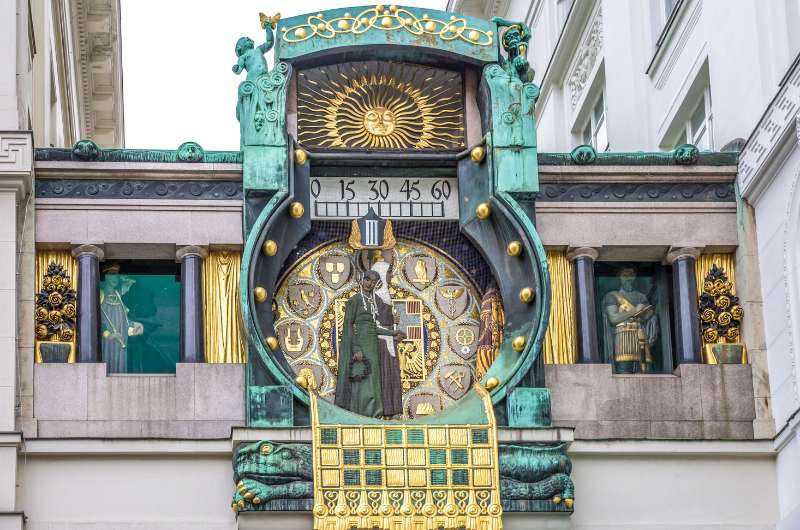
The Anker Clock
Time spent here: 10 minutes
Now, take a little quick stroll through the streets off of Stephansplatz. A couple blocks north is the Anker Clock, built in Art Nouveau design in 1914.
It forms a bridge between two buildings, with 12 figures “walking” through the little windows, each being showcased for 1 hour and accompanied by music on the hour every hour.
The main attraction is at noon when all 12 figures form a parade for all of the tourists on the street below. It takes about 10 minutes, so prepare for your neck to ache afterward!
Day 1—Vienna—stop 3: Time for Sacher!
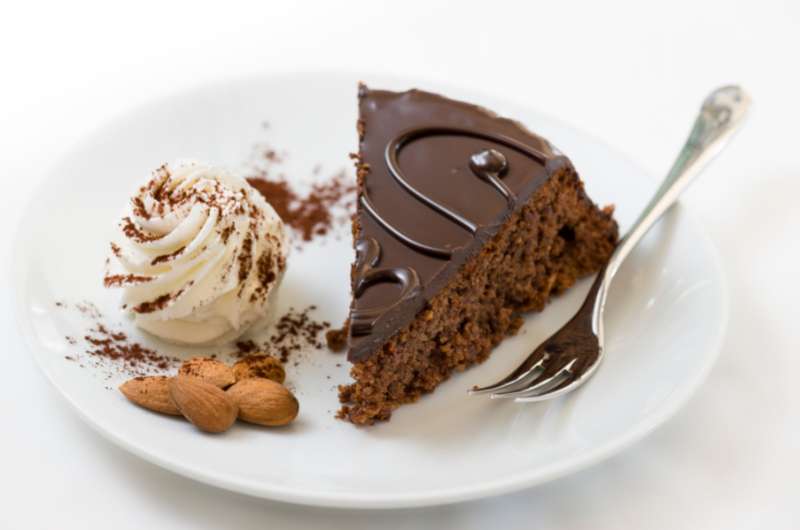
Yummy! Sacher
Time spent here: 1 hour
Is it ever too early for cake? Nah, and this one is a Viennese classic—Sachertorte is a decadent chocolate cake with apricot jam in the middle.
The home of Sachertorte is Café Sacher, a café with a typical Viennese coffeehouse atmosphere. It’s part of Hotel Sacher Wien, which is a fabulous, very Viennese, and very expensive 5-star hotel in the center of Vienna. If you book a stay there using my affiliate link, I will love you forever. I get a bit of commission at no extra cost to you, so all you’ll feel is a sense of fulfillment and joy.
You can walk to Hotel Sacher Wien from Stephansplatz in about 10 minutes using the pedestrian street called Kärntner Straße.
Café Sacher offers Sacher from an original 1832 recipe, so go and try the famous cake at its original home. It sits across from the State Opera so that you can get a glimpse of that on the way, too.
Making reservations is strongly recommended.
- Open daily 8 am–8 pm
Day 1—Vienna—stop 4: Belvedere
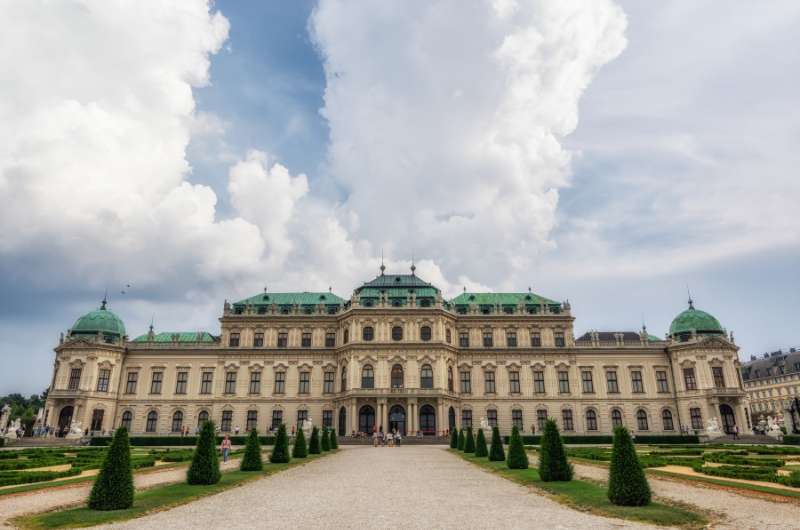
The Upper Belvedere
Time spent here: 2 hours to see at least one museum, min. 4 hours for everything
The Belvedere consists of the Upper Belvedere Palace (in the south), the Lower Belvedere Palace (in the north), and the 600 m (0.4 mile) long garden that’s between them, plus the Belvedere 21 art space.
It’s a big place, and you won’t have time to see everything unless you really prioritize it in your itinerary.
The Upper Belvedere is the main palace, bigger and grander, and houses a large Gustav Klimt collection, including his most famous work, “The Kiss”. Plus works by Schiele, Funke, Messerschmidt and van Gogh.
The Lower Belvedere and stables show special exhibitions and art from all periods. The palace is overall smaller and less grand but still nice. It’s where Prince Eugene used to live, so it’s not ordinary in the slightest.
If you’re more into contemporary art or think palaces are boring, visit the Belvedere 21 instead. It belongs under the Belvedere umbrella, but it’s a “vibrant urban hub” just a bit further south of the Upper Palace.
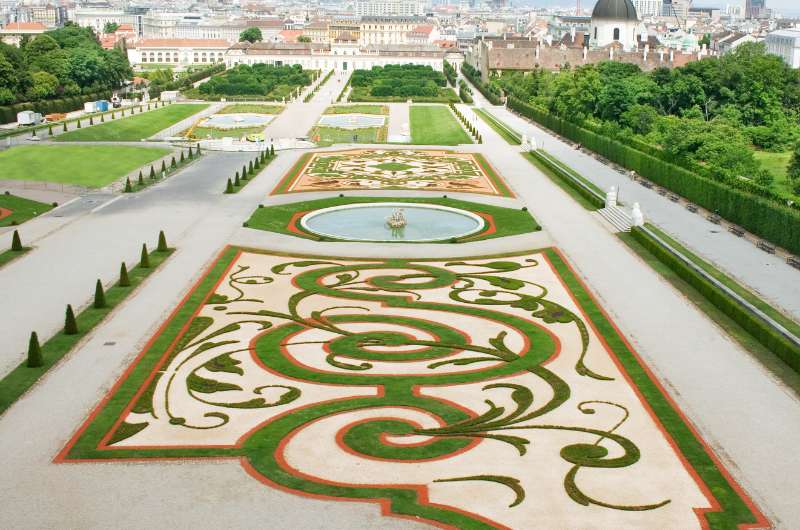
Belvedere gardens
The main garden is free to enter, as is the botanical garden. The Privy Garden is free if you have a palace ticket. Then there’s Europe’s oldest Alpine garden with over 100 bonsais and the main attraction—rhododendrons that blossom starting in April. You pay EUR 4 to see those (this garden is only open from the end of March to the beginning of August).
I love rhododendrons, so I’d certainly try to see the Alpine Garden if you’re visiting at the time when you can see the flowers in full bloom; it’s just spectacular.
- Open daily 10 am–6 pm
- Tickets cost EUR 15.90 for just the Upper Belvedere and EUR 22.90 for the Upper and Lower Belvedere. See the website for other combinations.
Day 1—Vienna—stop 5: Karlskirche
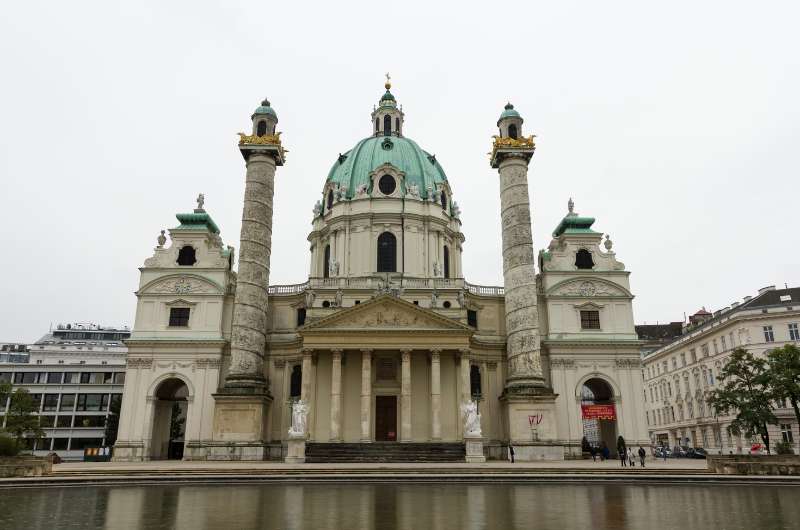
St. Charles Church (Karlskirche)
Time spent here: 20 minutes
Just a 10-minute walk back towards Vienna’s historic center is the Karlskirche, aka St. Charles Church. It’s considered the best Baroque church in Vienna but is a mix of styles: Byzantine, Renaissance, and Baroque with Greek and Roman elements. You’ll see what I mean when you see the two huge columns in the front.
There’s a slightly out-of-place metal elevator in the middle of the church that takes you up to the dome so you can stare at the ceiling frescos from way up close.
You can also go outside on the terrace for a nice view of the city and the fountain and park in front.
- Open Monday to Saturday 9 am–6 pm, Sundays 12 pm–7 pm
- Tickets cost EUR 8
Day 1—Vienna—stop 6: Rathausplatz and Town Hall
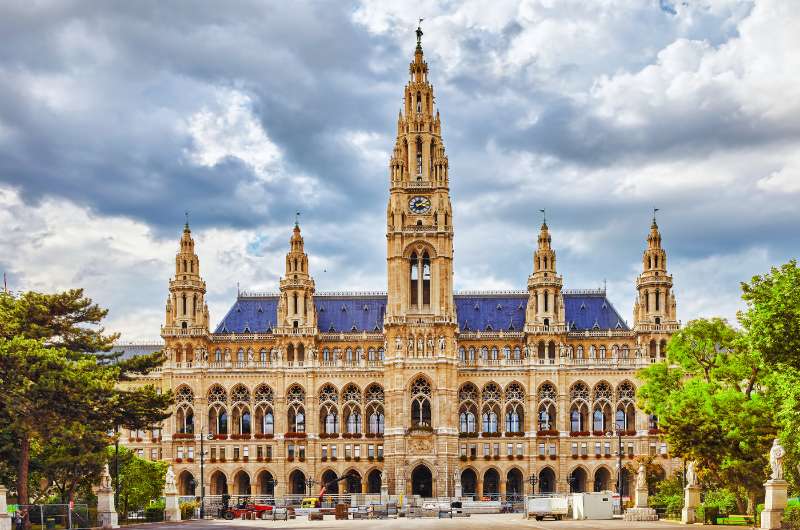
Rathausplatz Townhall
Time spent here: 20 minutes
Now, I suggest hopping on a tram on Oper, Karlsplatz, and getting off 4 stops later at Rathausplatz.
Rathausplatz is the square and park that’s always bustling with people and, especially in the summer and winter, plenty of events. The main focus point is the massive city hall or Rathaus.
The town hall’s façade is apparently modeled after Brussels’ Town Hall, which is the most eye-catching building on the already fabulous Grand Place in Belgium’s capital. Read more about Brussels’ highlights (including the Town Hall).
You can visit the Rathaus interiors (or some of the representative halls, at least) on a guided tour, but it is mostly offices full of officials who are going about their daily business. I prefer just seeing it from the outside.
If there’s nothing special going on when you’re visiting, you’ll only need a few minutes to take a look around.
Day 1—Vienna—stops 7+8: Hundertwasser House and Kunst Haus Wien
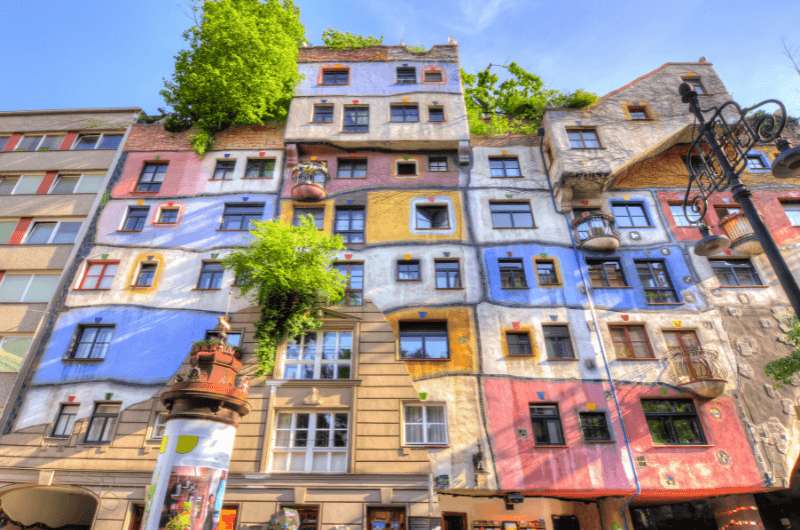
Hundertwasser House
Time spent here: 10 minutes
Hop back on the tram (no.. 1 takes you there directly) and go to Hertzgasse.
Hundertwasser House looks like you let kindergarten kids paint the façade, but in fact, it’s an architectural highlight, built in 1983–1985.
It’s an apartment building designed by Friedensreich Hundertwasser, a famed Austrian painter. He was given complete free reign in the design of the house, and his style was loud and clear. You will see bold colors, swirling designs, and grass and trees everywhere.
The building is still used as a residence, so you can only look at it from the outside.
- Hundertwasser House is on Kegelgasse 37–39
- Opening hours of the Hundertwasser Museum: 10 am-6 pm
- Tickets cost around 9,5 EUR
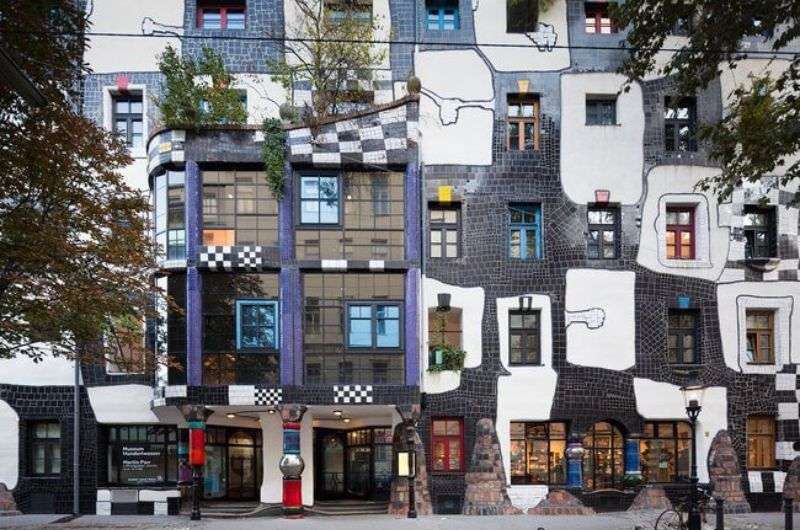
Kunst Haus Wien
Time spent here: 1 hour
A couple blocks down the road is the similarly quirky Kunst Haus Wien. This building was also designed by Friedensreich Hundertwasser. Inside, you can admire some top international exhibitions with a focus on photography, and it also serves as the Hundertwasser Museum.
Stick around at the café downstairs for more artsy vibes. You can also buy some souvenirs at the gift shop.
- Open daily 10 am–6 pm
- Tickets cost EUR 12
Day 2 of Austria itinerary: More of Vienna
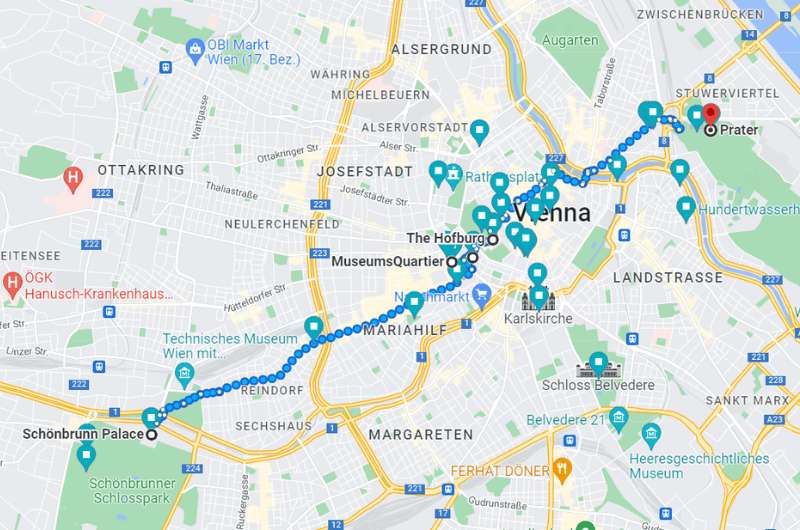
See this map in Google Maps so you can just click and walk
Main sites visited on day 2: Schönbrunn Palace and Gardens, Museum Quartier, Hofburg Palace and Heldenplatz, Prater’s Giant Ferris Wheel
Restaurant tips: KLYO | Superfood Deli | Dogenhof | Taeko Ramen
Hotel recommendations: Boutiquehotel Das Tyrol
Further reading: Unusual Places in Vienna
On today’s Vienna itinerary, you’ll start at Schönbrunn Palace, spend some time in Vienna’s museums in the center, and end your day at the funniest place in town, Prater.
Day 2—Vienna—stop 1: Schönbrunn Palace and Gardens
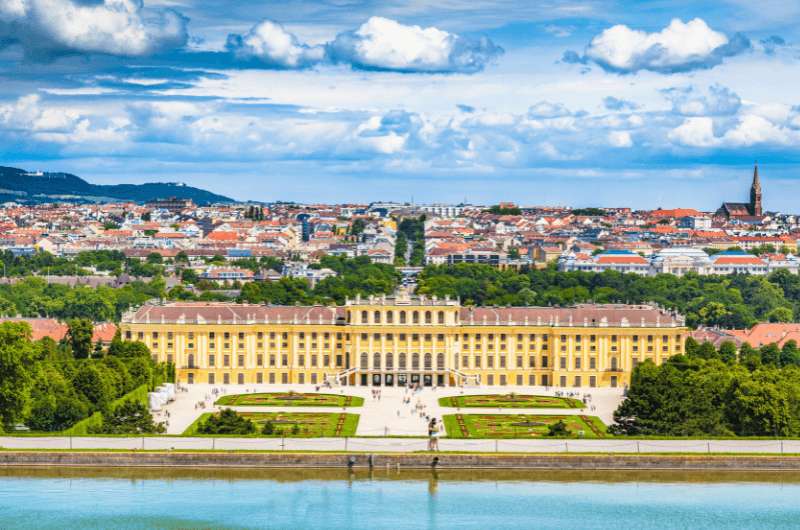
Schönbrunn Palace—the Austrian Versailles
Time spent here: 2 hours minimum
Right away, I have to warn you that the gardens are so vast that if you wanted to visit everything there (like the Palm House and Zoo), you’d have trouble seeing it all in a full day. So come here ready to just get a taste of Schönbrunn.
Schönbrunn Palace is an imperial summer residence in Baroque style, kind of like the Austrian version of Versailles.
A visit to Schönbrunn is easily worth it, even if you decide against visiting the palace interiors. The gardens are huge and are worth visiting in their own right. There are fountains, lakes, statues, ruins, a rose garden, and many beautiful avenues to walk through.
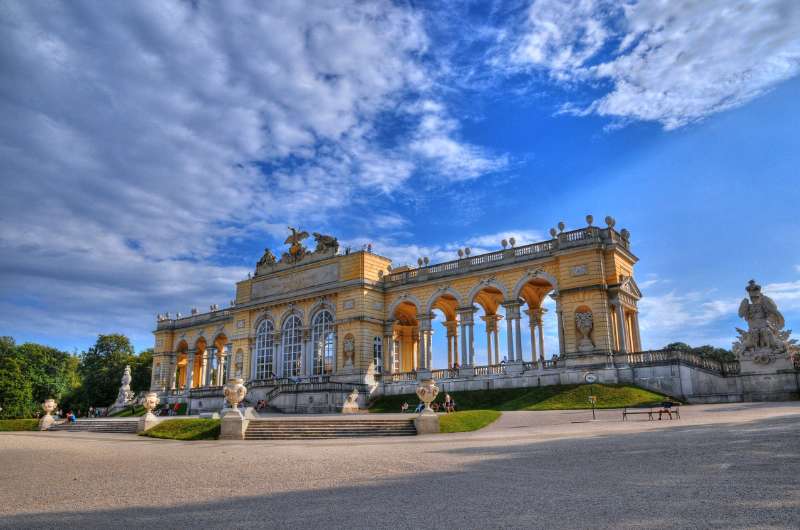
Gloriette Schloss—the best place to photograph the Schönbrunn Palace
Entrance to the Schönbrunn Gardens is free.
I recommend that you stop at Gloriette Viewing Terrace. Not only is it pretty on its own, especially when viewed from over the lake, but the entrance is free , and you can get perfect photos of Schönbrunn Palace from there. You’ll get the palace gardens in front and the city in the background; it’s pretty cool.
If you want to see the interiors, Schönbrunn offers a good variety of tours, like the Imperial Tour, which takes you through 22 rooms with an audio guide and takes just about 30 minutes.
Make sure to book tickets in advance. Especially in the summer months, there can be crowds trying to get in, and they do limit the number of people inside, which results in hours of waiting.
Schönbrunn’s located a bit of a way away from the city center, but you can easily get there by tram, bus, or metro (Schloss Schönbrunn is the stop you’re looking for), and obviously by taxi, too. If you have your car, there is a parking lot ready to babysit your vehicle for EUR 4 per hour.
- Open daily 8:30 am–5:30 pm most of the year for the palace, 6:30 am–8 pm for the gardens (shorter opening times in the winter; check website for details)
- Entrance to the gardens is free. Tickets to the palace vary depending on which tour you choose. For example, the Imperial Tour costs EUR 2,2 including an audio guide.
Day 2—Vienna—stop 2: Museum Quartier and some museums
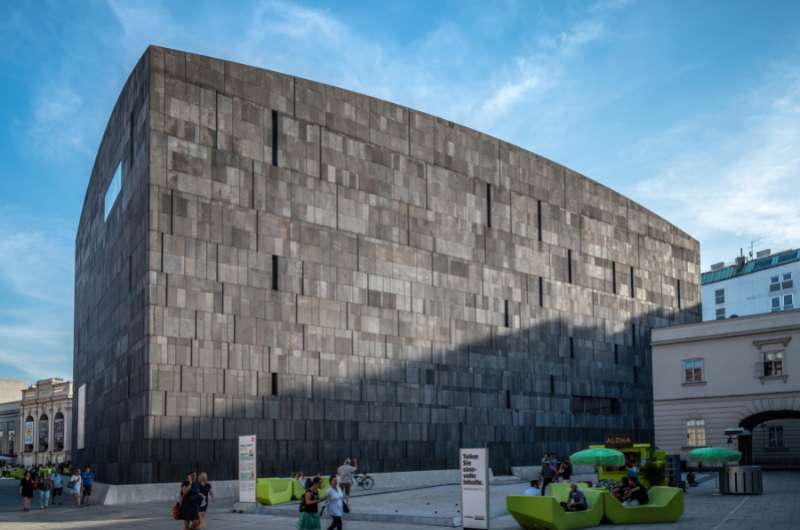
Mumok Museum
Time spent here: 2 hours
Go back to Vienna’s city center to the Museum Quartier, a museum neighborhood that’s a pleasant combination of historical buildings, modern architecture, and (sometimes strange) art.
You can stroll around Museum Quartier, looking at the outdoor art and popping in for a coffee if you feel like it. There are several restaurants/ cafes right in the main courtyard, and most museums have their coffee offering as well.
Tip: If you are a book nerd, stop by the Buchhandlung Walther König. It’s a cool little bookshop with tons of art books.
Most of the museums here are art galleries focusing on modern art. Choose one based on your interests.
The mumok is the big, grey, windowless one that screams “I’m a contemporary art museum”. It has some very wacky pieces that you’ll either love or hate.
Alternatively, try the Austrian Architecture Museum, the Leopold Museum (Austrian modern art), international contemporary art at the Kunsthalle, or the interactive children’s museum called ZOOM.
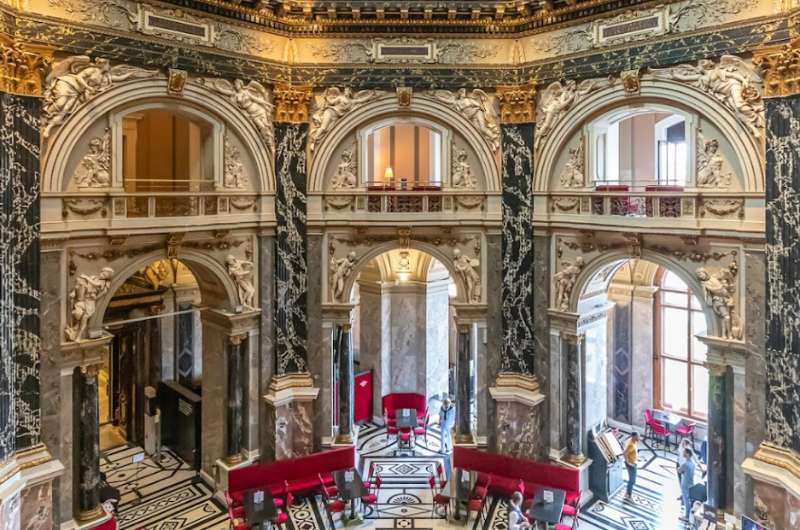
The interiors of the Kunsthistorisches Museum are incredible
If none of that sounds interesting and you’d like to step back in time instead of into the future, you can head across the street to the Kunsthistorisches Museum, aka Vienna’s Art History Museum. Even if you just take a minute to look at the incredibly ornate dome in the entrance hall, it’s worth a stop.
Day 2—Vienna—stop 3: Hofburg Palace and Heldenplatz
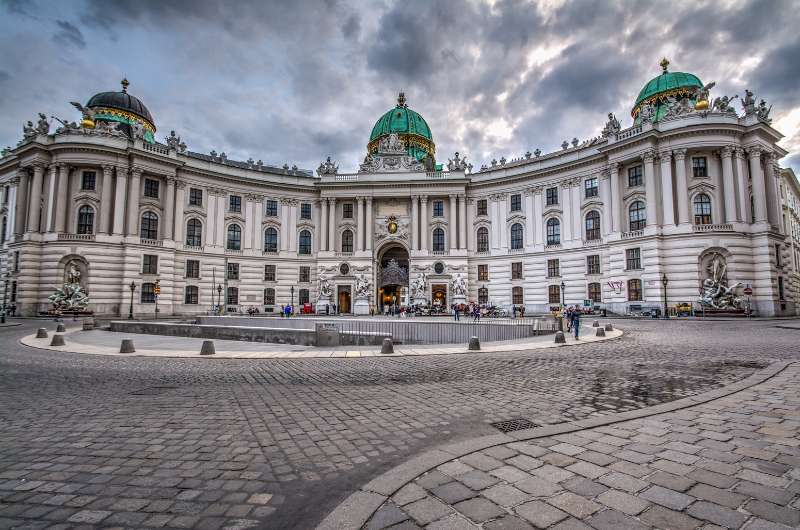
Hofburg Imperial Palace
Time spent here: 1–2 hours for just the exteriors
The next spot you’ll want to visit is one of the biggest palace complexes in the world: Hofburg Palace. It might sound surprising since it’s in the middle of Vienna, but the place is vast!
Having said that, visiting all the interiors in the Hofburg complex would take you all day, so for this visit, I recommend just spending time outside. There’s still a lot to see.
Hofburg is where the Habsburg Empire was ruled for centuries. The kings moved out in 1918, but Austria’s president still takes care of all his boss's duties from there to this day.
Aside from being a place to manage an empire (or country), Hofburg serves as a place for many museums. There’s also the Imperial Chapel, the Austrian National Library, the Imperial Treasury, and even the Spanish Riding School.
Tip: I’ve included the Spanish Riding School in my article about unusual places to visit in Vienna. It’s home to the Lipizzaner stallions and is the oldest classical horse-riding school in the world.
If you do visit the interiors of Hofburg Palace, you’ll be able to see the private apartments and representative rooms of Emperor Franz Joseph and Empress Elisabeth and get a feel for what it was like to be part of the imperial family.
The square in front of the Imperial Palace is called Heldenplatz. You get the best views of the palace from there, along with some statues of important men on horses.
Walking away from the palace, the square turns into the Volksgarten, a large, regal public park that includes fountains, manicured flower gardens, a rose garden, and even a replica of a Greek temple.
- Opening times vary from building to building, but in general, 10 am–6 pm daily should get you into most places.
- Tickets to the apartments, the Sisi Museum, and the Silver Collection cost EUR 16. Other ticket options are available. Just walking around the complex and gardens is free.
Day 2—Vienna—stop 4: Prater’s Giant Ferris Wheel
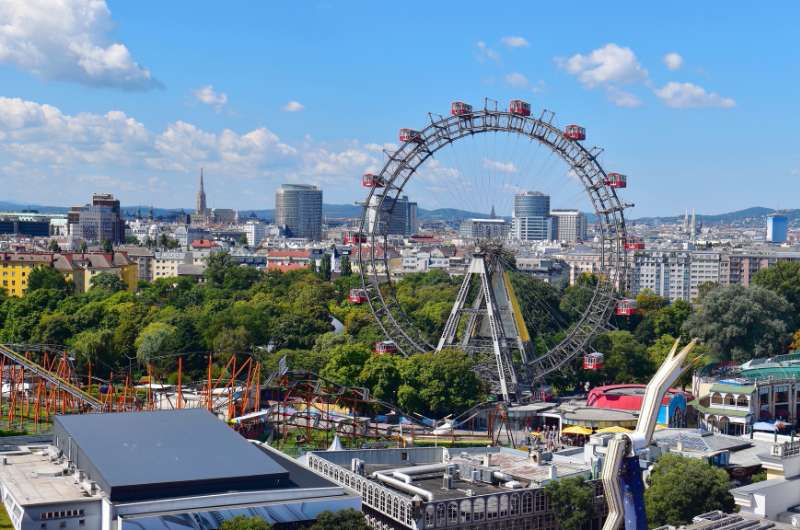
Who has never heard of the famous Prater Amusement Park?
Time spent here: However long you wish; the ride itself takes about 15 minutes
The day is almost at its end, so it’s time for some fun! Hop in a taxi and head out to one of Vienna’s most prominent symbols, the Ferris Wheel (“Wiener Riesenrad”).
Located in Prater Amusement Park to the north of Vienna’s city center, The Giant Ferris Wheel. It’s been adorning Vienna’s skyline for over 100 years.
You can either just take a ride in one of the wooden cabins—that takes about 15 minutes—or, turn it into an extra special experience:
- For a kick of adrenaline, hop on Platform 9. You’ll get a harness, and then you’ll be strapped onto a simple steel construction with a glass floor! Up you go! Tickets cost EUR 89.
- For a culinary experience, buy tickets (in advance) to one of the gourmet wagons and go round and round while you eat! It won’t come cheap, though—a dinner for 2 starts at EUR 260.
- Before or after your ride, visit the Panorama at the foot of the Ferris Wheel to learn about the history of the Wheel through audio-visual installations in eight Ferris Wheel cabins.
Of course, the rest of Prater is right there, so if you’re up for it, continue your evening on some fun rides! Each ride is paid for separately, so you can even just wander around and enjoy the atmosphere without paying any kind of entrance fee.
- Open (almost) daily year-round, mostly morning until midnight.
- Tickets cost EUR 13.50 for adults.
Day 3 of Austria itinerary: Drive from Vienna to Salzburg, visit Schloss Ort
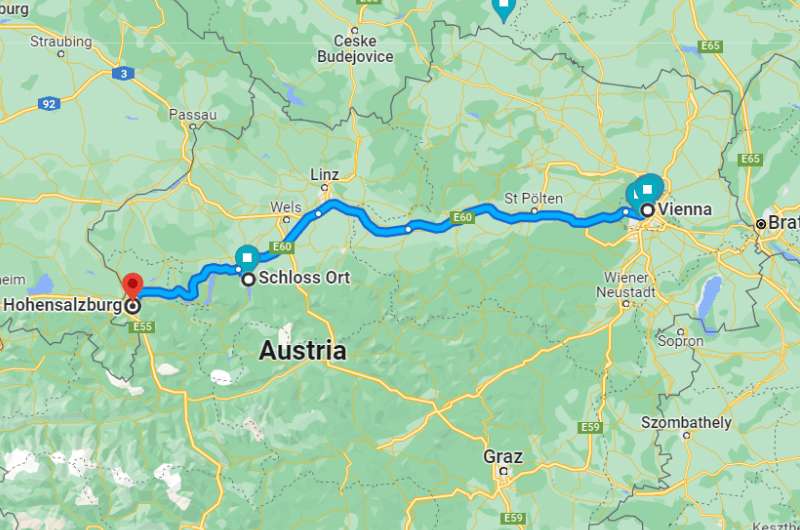
The best way to get from Vienna to Salzburg
Main sites visited on day 3: Schloss Ort, Salzburg Fortress, Salzburg Old Town
Restaurant tips: Marc's Restaurant-Bar in Salzburg | Rudolsfturm | Seecafé Hallstatt
Hotel recommendations: COOEE Alpin Hotel in Gosau (book for 3 nights)
Further reading: Best places to visit in Salzburg | Best places in Hallstatt
Today you’ll be driving from Vienna to Salzburg, stopping at a water castle, and ending your day in your hotel in Hallstatt –that's right, not in Salzburg. It’s because Salzburg is boring and Hallstatt is not.
Your hotel in Hallstatt...sort of
I’ve taken extra care to recommend really good hotels in this super cute town, so feel free to make use of those affiliate links! You pay nothing extra, and I get a small commission if you do.
When I say “in” Hallstatt, I don’t necessarily mean “in” Hallstatt—any of the neighboring villages will do. If you want to take my advice, stay where I stayed:
The COOEE Alpin Hotel in Gosau was an amazing place. Nice, spacious bedrooms, a wonderful breakfast, and an awesome location. There is also a sauna at the hotel and free parking.
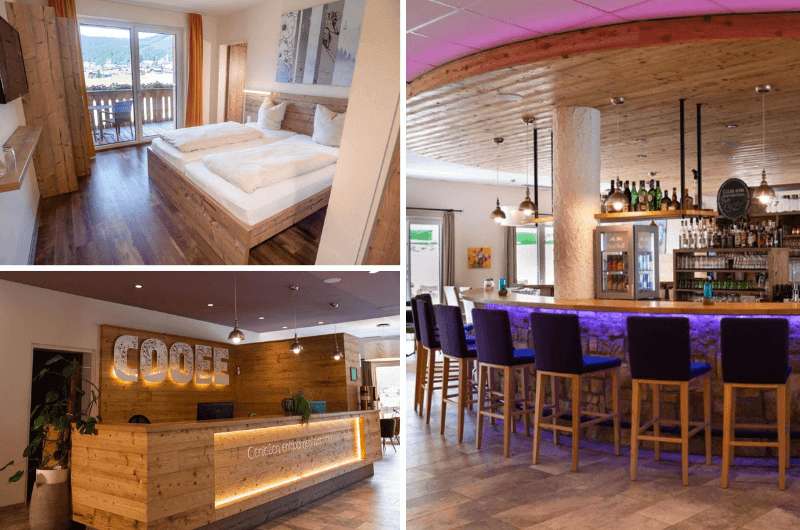
Instead of staying in Hallstatt, stay in Gosau’s COOEE Alpin Hotel
Day 3, stop 1: Schloss Ort
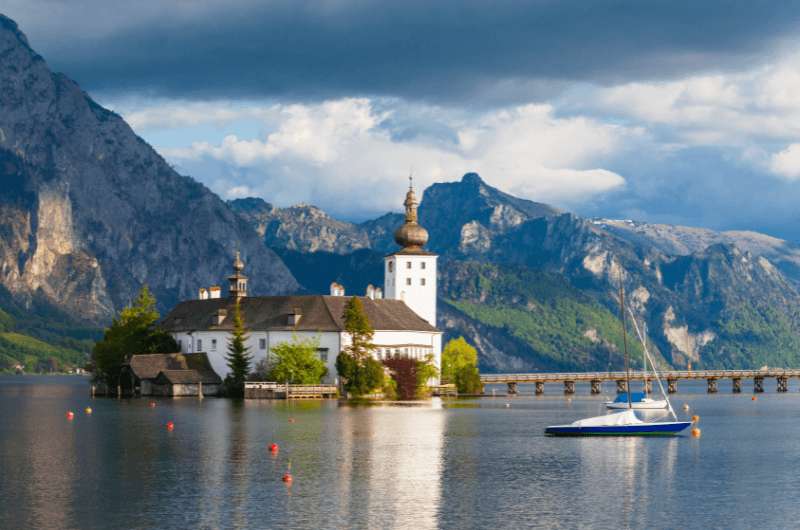
Schloss Ort and the mountains view
Time spent here: 1 hour
The drive to Salzburg from Vienna takes 3.5 hours without stops, so you’ll want to break that up a bit. Austria’s lakes make for the perfect excuse to get out of the car and stretch your legs.
At Schloss Ort in a town called Gmunden, you can get amazing views of the lake and the Alps from a tiny island, and with a small castle to boot. It’s about 2.5 hours into your drive.
To set expectations straight, the castle is fun to visit because there is a narrow wooden walkway out onto the lake to it, and the views are fantastic from there and the peninsula that it leads from. The castle isn’t an actual tourist site, apart from the courtyard with a small museum about peasant life. You pay EUR 5 to walk inside, even just the courtyard.
The only other way to see more of the inside of the castle is to have a wedding there, and there’s no time for that on this Austria itinerary! This isn’t Vegas ok?
You can take advantage of the onsite café (accessible without paying the entrance fee) and take in those views with a mélange in your hand.
The little island that the castle sits on is reached by walking across a bridge from the peninsula that includes a nice park area called Toscanapark.
Park your car in the large and free parking lot right at the start of the peninsula.
- Parking lot map
- Open daily 10 am–5 pm
Day 3, stop 2: Salzburg Fortress and the city
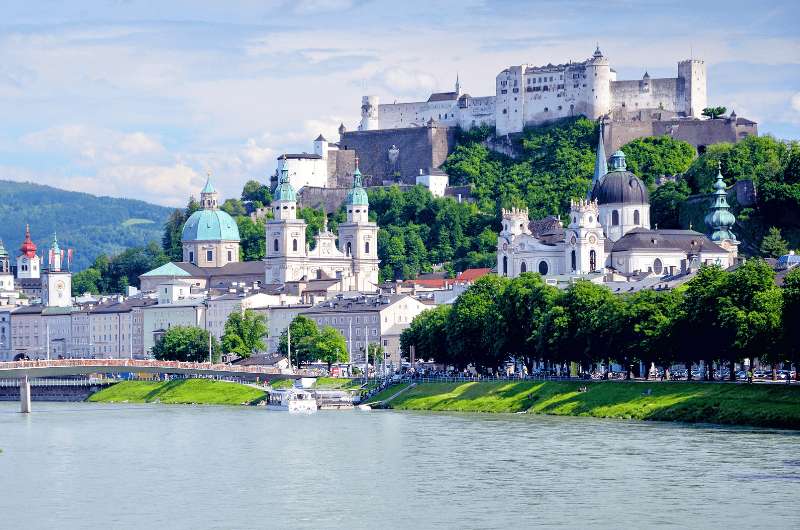
Salzburg in all its beauty
Time spent here: 2 hours for the fortress, indefinite for the city
I’m not a huge Salzburg fan (boring!), so I think you don’t need to kill yourself trying to see the entire town if you’re short on time or energy. The one part I do recommend visiting is the fortress—Festung Hohensalzburg. But even that isn’t that amazing. Not inside, at least.
Salzburg’s fortress is an eye-catching part of Salzburg’s skyline because it site perched atop a hill right above the city center. It’s one of the largest (still existing) 11th-century fortress complexes in Europe.
There are several options for tickets for Salzburg Fortress, so just choose what sounds most appealing. I thought the interiors weren’t the greatest, aside from maybe the armory. The private bathroom in the Archbishop’s bedroom was a unique sight, too!
If you buy your tickets online, you skip the inevitable lines at the entrance.
How to get to Salzburg Fortress
You have to leave your car under the hill somewhere in the city. The closest and most convenient parking for Salzburg Fortress is at Mönchsberggarage. It’s underground and there’s enough space for everyone. If you get your parking ticket stamped at the fortress, you only pay EUR 4 for under 4 hours and EUR 6 for longer.
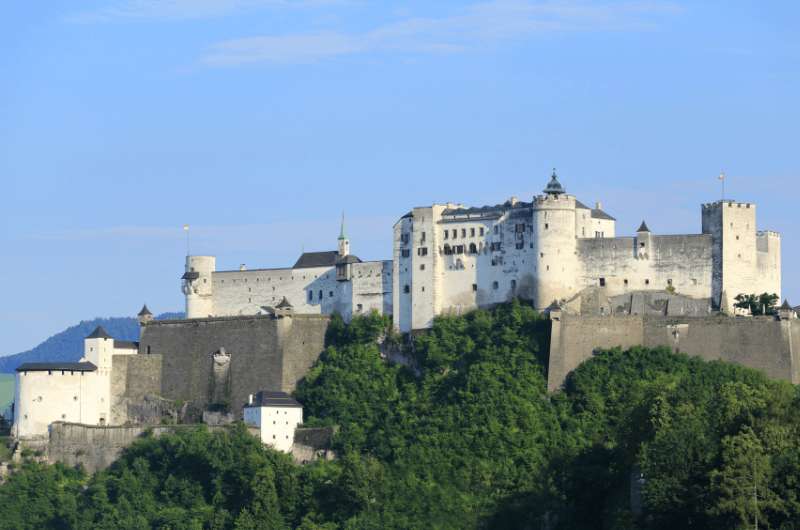
Salzburg Fortress—Hohensalzburg
You can either hike for 15 minutes to get up to the fortress or hop on the funicular at Festungsgasse 4. The ride-up only takes a minute. The funicular price is included in the fortress ticket, so buy it as a combination. If you only want to take the cable car up the hill, it costs something like EUR 4.5.
If you get stuck in cable car traffic, don’t be afraid to tuck into the little café right by the bottom station. It’s a simple place that serves simple food at good prices.
Right when you get out of the funicular, turn right and head to the terrace. You’ll get views of the city and of the mountains, and it’s arguably the most impressive part of Festung Hohensalzburg.
- Open daily 8:30 am–8 pm between May and September, opening times vary in other months
- Ticket prices start at EUR 13.30 for the basic pathway with the funicular included
What to see in Salzburg in one day
Other than the Salzburg fortress, I have a whole article on what to see in Salzburg that also includes an itinerary for a 1- and 2-day trip, so jump on over to that for details of other spots that you might want to see in the city.
For example, you might want to visit the Salzburger Weihnachtsmuseum. A small museum with a historical collection of Christmas decorations, toys, and various Christmas-related this and that.
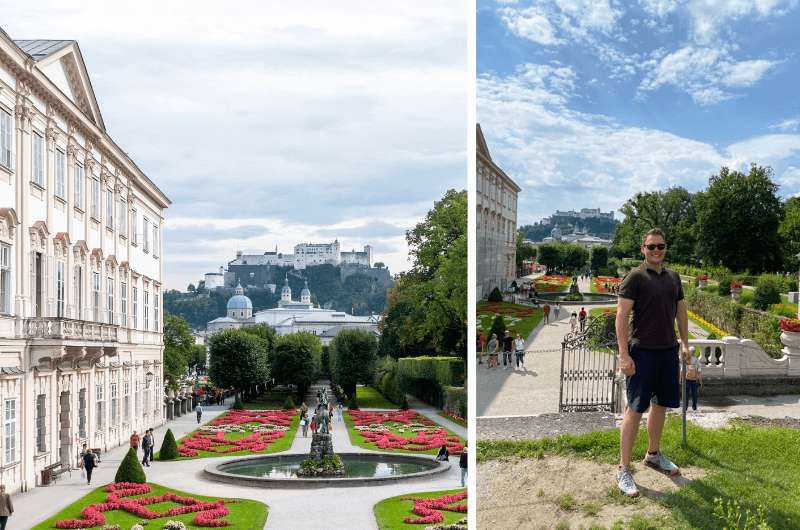
Visiting Residenzplatz on the left and Mirabell Gardens on the right
Besides the fortress and some Christmas fun, you can spend some time around Residenzplatz (the Residence Square), with all the mandatory sights at your fingertips: Salzburg Cathedral, DomQuarter/Alte Residenz, Neue Residenz with the famous Glockenspiel (nowadays home of the Salzburg Museum), St. Peter’s Monastery, Cemetery, and Catacombs.
Once you’re done in Salzburg, drive the 1 hour to my favorite Austrian city—Hallstatt. It’s more of a village, but you’ll love it, I’m sure of it!
Day 4 of Austria itinerary: Hallstatt
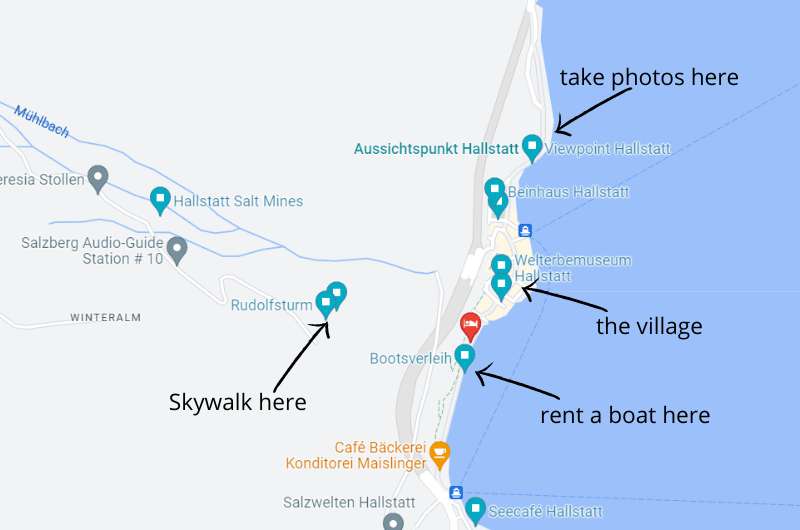
See Hallstatt’s highlights in Google Maps
Main sites visited on day 4: Salt mines, Skywalk, the church and ossuary, Hallstatt Museum, boat tour
Restaurant tips: Rudolsfturm | Seecafé Hallstatt
Further reading: Best places to visit in Hallstatt
Today, you’ll stay put in Hallstatt, my favorite Austrian village. It’s small, but it certainly warrants a full day to visit!
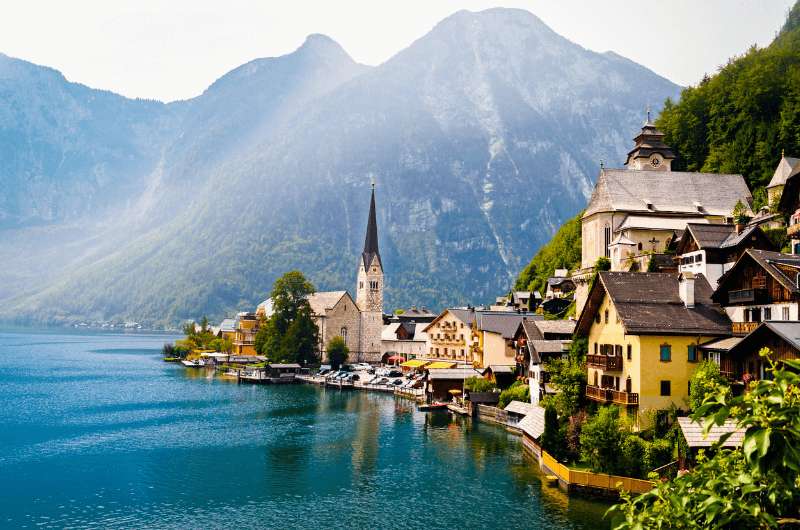
Get this exact photo from this viewpoint
Get up bright and early and head out to explore the cutesy alleys of Hallstatt before the rest of the hordes of tourists do. You can literally see the whole thing in 20 minutes, so just take a wander. Don’t forget to make your way out to this viewpoint north of town for the best photo ops.
Day 4—Hallstatt—stops 1+2: Salt mines and Skywalk
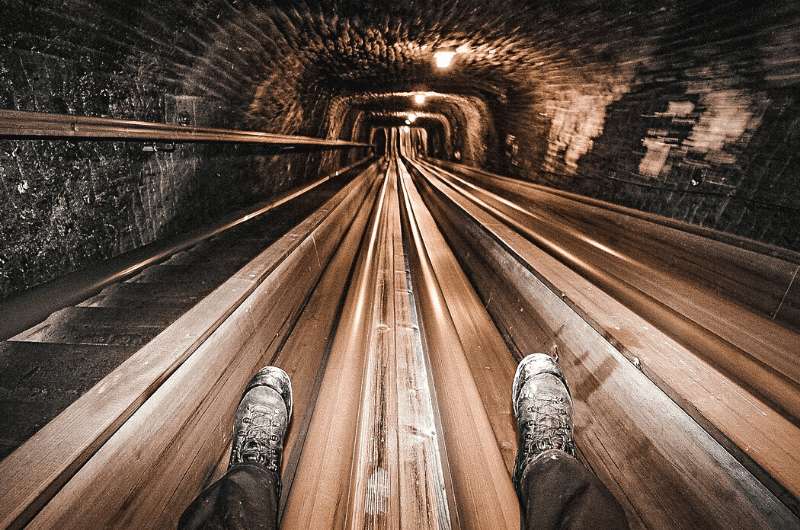
A wooden underground slide as part of the tour? Yes, please! @ the Hallstatt Salt Mines
Time spent here: 2 hours + time for lunch
Take the funicular up the mountain so you can head into the salt mines—Salzwelten Hallstatt.
Hallstatt gained its glory mainly for salt mining, the Hallstatt Salt Mines (Salzwelten). It’s the oldest salt mine in the world, with a 7,000-year history. The ancient tribes were working in these mines 7,000 years ago, which means the mines are older than the Egyptian pyramids!
The tour of the salt mines is super fun—it starts with a train ride and includes going between the individual floors on wooden slides! You can get details of my visit to the salt mines in my Hallstatt article.
The salt mine combination ticket (EUR 36) also gets you into the second-best experience in Hallstatt—the Hallstatt Skywalk (Welterbeblick).
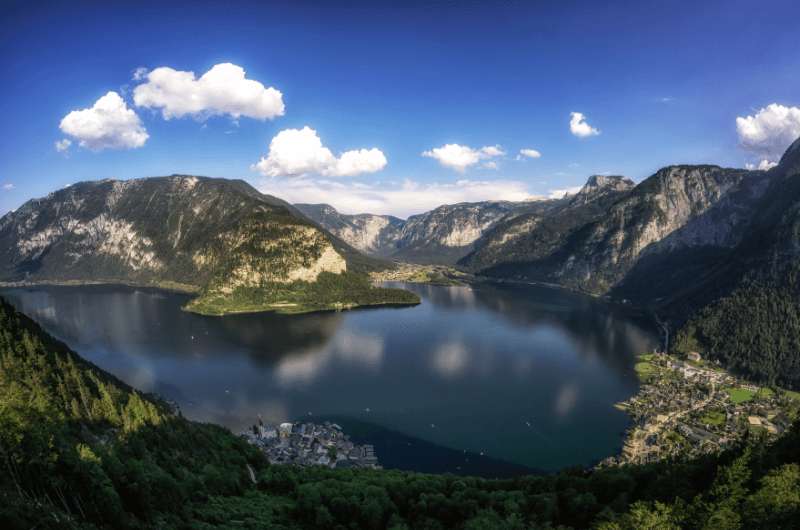
The view from Salzburg Skywalk
The same Salzbergbahn funicular will take you up 838 m (2,750 ft) onto the mountain. Then, cross the suspension bridge leading to Rudolf’s tower, and right under the tower, you will see the viewpoint platform.
Yes, the platform hangs there as if in thin air, and yes, the views are spectacular.
If you grab lunch at Rudolfsturm Restaurant (at the aforementioned Rudolf’s Tower), you’ll be eating with the best views far and wide!
- Open daily 9:30 am–4 pm between April and November, opening times vary in other months
- Tickets cost EUR 36 for the salt mines and the funicular that takes you to both the mines and the Skywalk
Day 4—Hallstatt—stop 3: The church and the ossuary
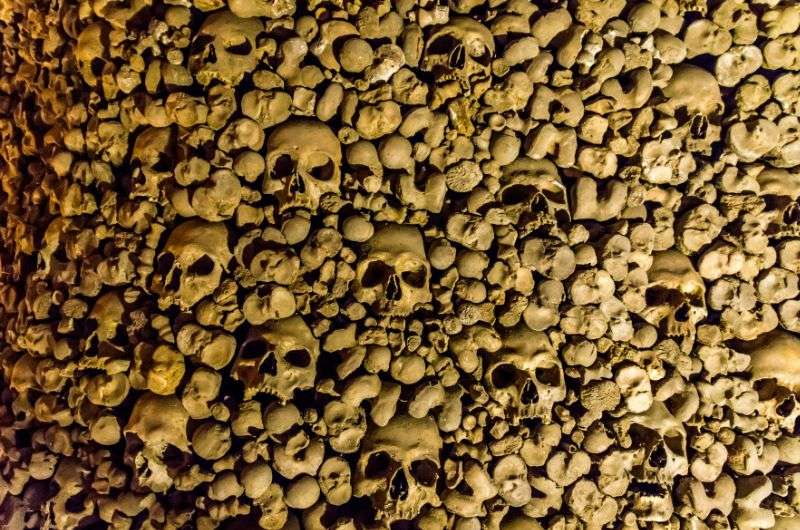
The collection of skulls in the Pfarrkirche Mariä Himmelfahrt Beinhaus
Time spent here: 1 hour
On the hill little ways over the city, the Catholic church called Pfarrkirche Mariä Himmelfahrt guards the ancient cemetery. As you can see, the cemetery is rather small, so the residents decided to make an ossuary in the small chapel of St. Michael to store the remains of their ancestors.
In the Beinhaus (the “bone house”), there are more than 1,200 skulls, and around 600 of these are hand-painted with names and ornaments.
- The ossuary is open Wednesday to Sunday from 11:30 am–3:30 pm
- There is a EUR 1.50 entrance fee
Day 4—Hallstatt—stop 4: The museum and excavations
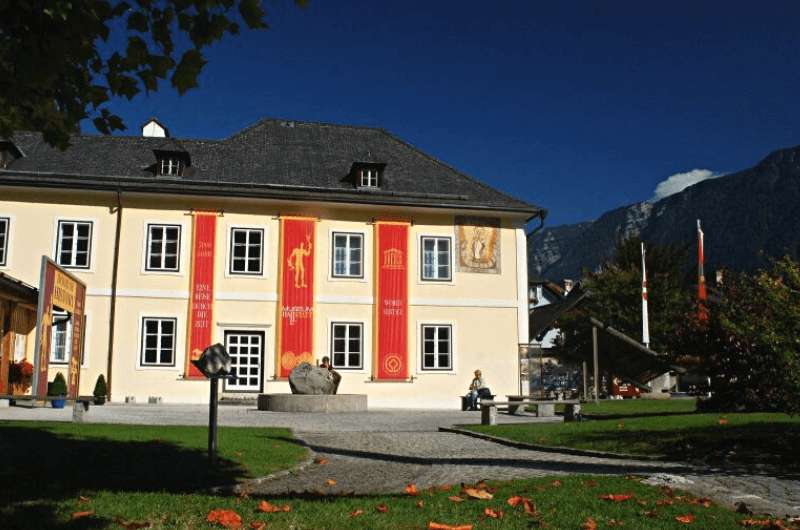
Hallstatt’s museum
Time spent here: 1 hour
Next, visit Hallstatt’s Welterbemuseum to learn more about its history, from its salt mining days to more recent history.
It’s a nice little museum that gives you some extra appreciation of the city. You can be in and out in 30 minutes unless you are really interested in all the exhibits.
- Open daily 10 am – 6 pm (May to September; check website for opening times in other months)
- Tickets cost EUR 10
Just a few steps from the museum, across the little square, there is a sports equipment store. And no, I’m not telling you to go buy tennis shoes. There’s an excavation site under the store!
It was discovered by accident when the owner of the house wanted to build a boiler room under the store. The archeologists and students from the University of Vienna were summoned to explore the site and today you can see a number of excavation pieces and ancient walls from different parts of Hallstatt's rich history.
It’s open daily from 9 am to 6 pm and costs absolutely nothing.
Day 4—Hallstatt—stop 5: Boat trip on the lake
As the evening nears, I thought it would be a nice touch to get another perspective over Hallstatt from the lake—on a boat tour.
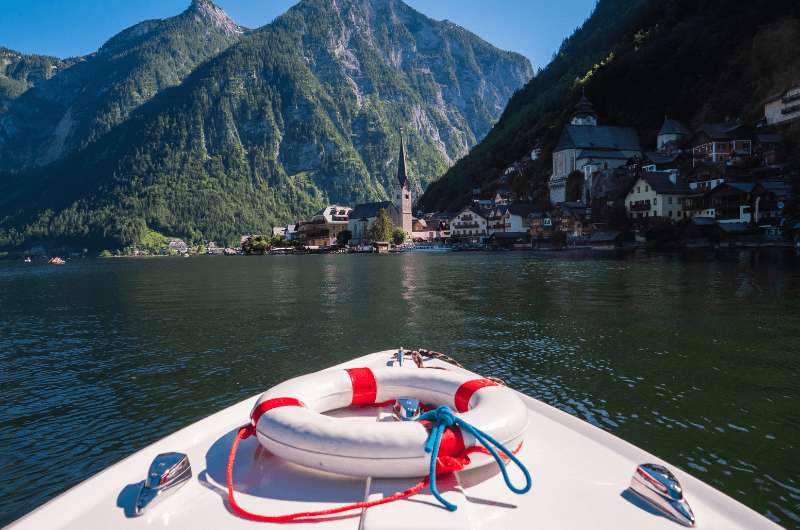
Rent your own electric boat on Hallstatt Lake
But skip the tourist boats and stay away from the rude boat rental places in the village center and rent your little electric boat from Bootsvermietung Schwarzmayr. Yes, you will be the captain, and don’t worry, it’s easy enough!
There’s room for 4 people, and the price for a 1-hour rental is EUR 27. Take cash, they don’t accept cards!
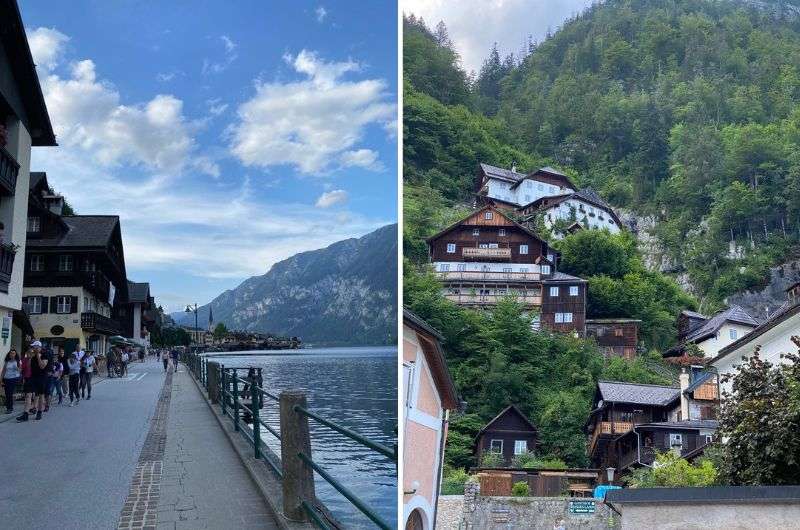
Hallstatt, Austria—historic lakeside gem shaped by salt mining and centuries of resilience
Day 5 of the itinerary for Austria: Dachstein Krippenstein
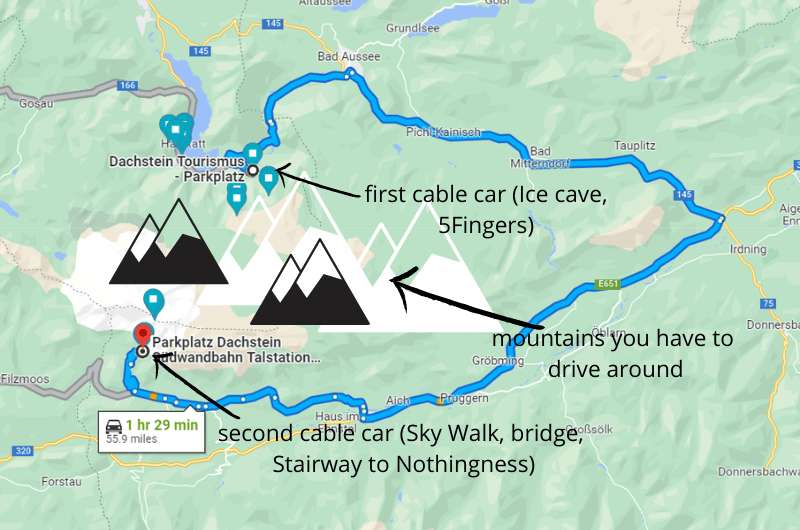
Today’s driving route from Hallstatt to 2 different Dachstein cable cars
Main sites visited on day 5: Giant Ice Cave, 5Fingers Viewpoint, Sky Walk, Stairway to Nothingness, Suspension Bridge
Restaurant tips: Gasthof Hunerkogel (near Dachstein gondola) | Rudolsfturm | Seecafé Hallstatt
Hotel recommendations: COOEE Alpin Hotel in Gosau
Further reading: Best places to visit in Hallstatt
Day 5—Dachstein—stop 1: Caves
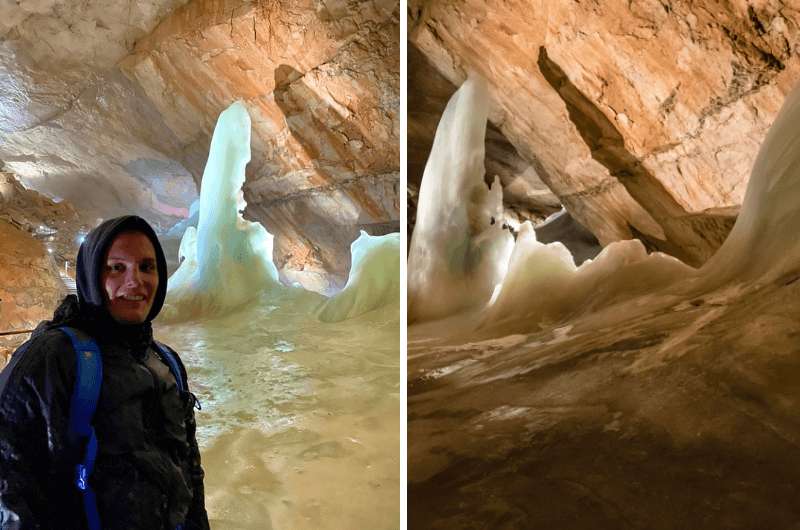
Me, freezing but kinda enjoying it in the Dachstein Cave
Time spent here: 2 hours
The entire region of Hallstatt-Dachstein/Salzkammergut is on the UNESCO list as a cultural landscape, so there’s a lot to explore.
Across the Hallstättersee from Hallstatt lies Obertraun village, and behind the village, there is a large cave complex inside the Dachstein Krippenstein Mountains (a popular ski resort in the winter).
There are several caves you can explore, so decide on a plan ahead of time so you know which cable car station to get off at.
There is a huge Mammut cave, one of the largest karst caves in the world, the Koppenbrüller cave with an underground lake, and my favorite, the Giant Ice Cave (I already covered this one in my article about 11 Top Tourist Attractions in Austria). Roam the caves and sink in the mysterious atmosphere of the underground kingdom.
The opening times of the caves are tied to the operation of the cable car, which rides every 15 minutes. Prices for the cable car start at EUR 35, and tickets that also include a cave start at EUR 40.
You can park your car at the huge parking lot by the bottom cable car station.
Day 5—Dachstein—stop 2: 5Fingers viewing platform
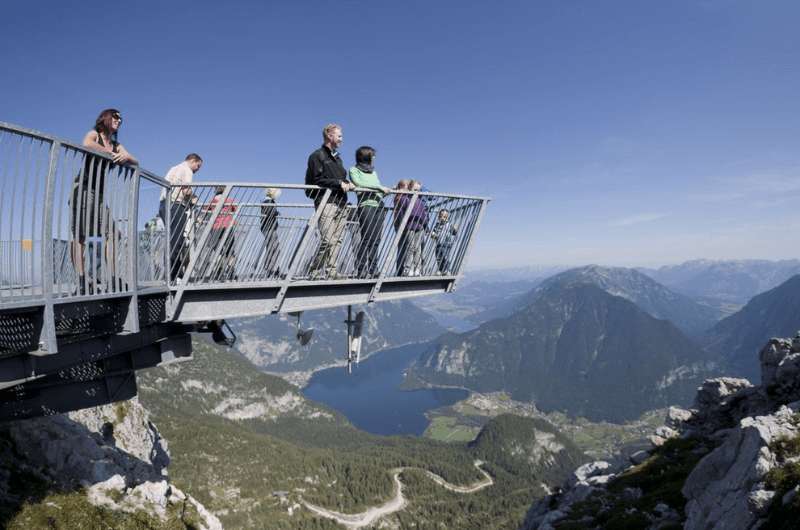
The incredible 5Fingers!
Time spent here: 30 minutes
Continue up from the caves by cable car to reach the 5fingers viewing platform.
Located over a 400 m (1,312 ft) drop, it offers a spectacular view over Hallstatt, the Hallstättersee, and the mighty mountain range.
There are 5 different fingers that you can stand in on the viewing platform.
If you continue to hike a little further, you reach the World Heritage Spiral (Welterbespirale) at 2,100 m (6,890 ft), where you get a 360° view of the Dachstain and Salzkammergut region.
And if it’s still not enough for you, you can choose one of the official Dachstein hiking trails.
Day 5—Dachstein—stop 3: The other side of the mountain
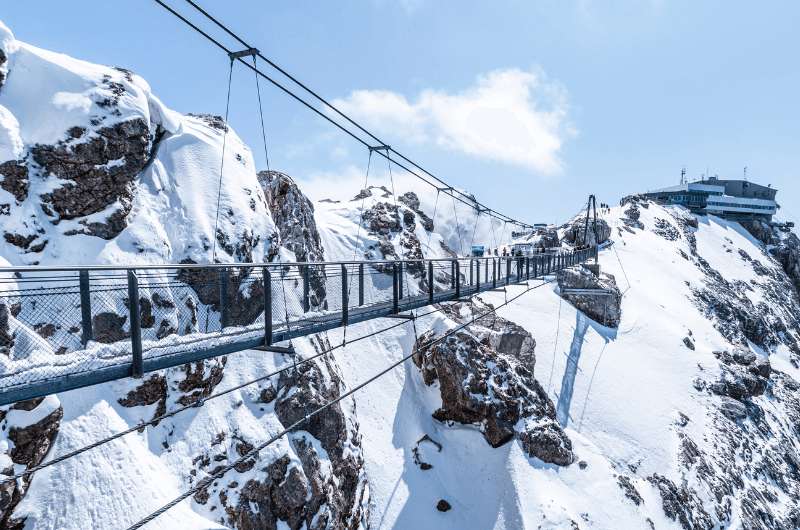
Dachstein Suspension Bridge
Time spent here: 2 hours
For this next bit, you’ll need to drive around to the other side of the mountain to find a different gondola. It’ll take you about 1.5 hours (it’s about 90 km/55 miles).
Don’t be deterred by the EUR 20 toll for the last part of the road that leads to the parking lot. Just make sure you get your toll ticket validated at the cable car ticket office, and then your toll will be waived.
The views from the gondola are already stunning, but when you get to the top, it’s like a mountain Disneyland! I mean that in the best way possible.
At an altitude of almost 3,000 m (9,840 ft), several attractions await, each more exciting than the last. First, you can try the Sky Walk—a glass viewing platform on the top of the 250-meter (820 ft) long vertical rock face. Followed by the Suspension Bridge and the Stairway to Nothingness.
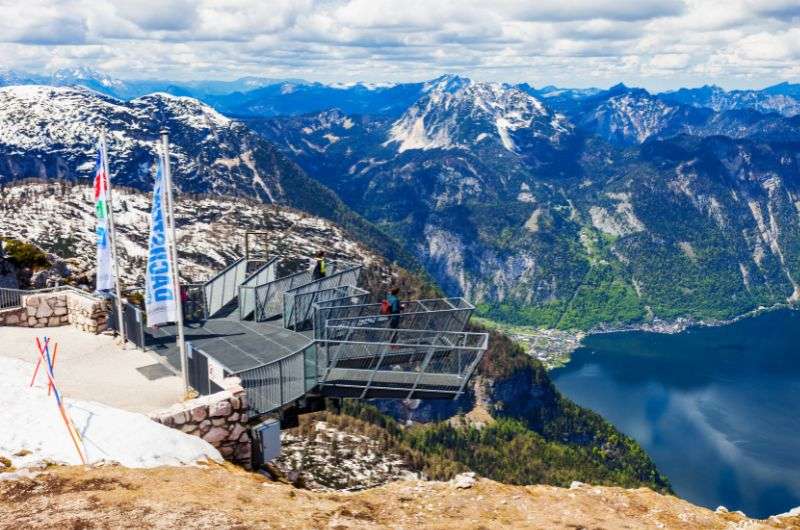
Stairway to Nothingness
For normal people, it's a breathtaking experience. If you fear heights, it might be a heart-attack experience. The bridge takes you to the final 14 narrow steps down to a glass platform in the middle of nowhere, so you might feel like you’re just hovering in the air over the mountain peaks. There’s also an Ice Palace on the top, a restaurant, and of course, several slopes for skiing.
The steep cable car price of EUR 47 takes you up and down Dachstein and already includes all of the attractions, so if you feel it’s too much, you need to stare out at the views some more. It’s worth it!
In the “summer” months (May to September), it’s advised to make a gondola reservation because the crowds that want to go up the mountain are a little too much for the capacity of the gondolas.
Make sure to bring warm jackets and good shoes, even in the summer!
Day 6 of Austria itinerary: Between Hallstatt and Zell am See
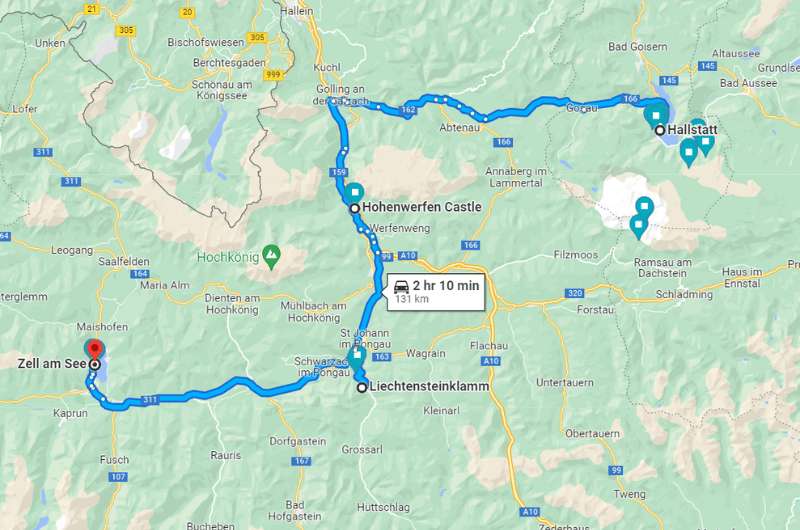
This is your driving route for day 6 of your Austria travel itinerary
Main sites visited on day 6: Hohenwerfen Castle, Liechtenstein Gorge, Zell am See
Restaurant tips: Seebar | Kraftwerk restaurant & winebar | Deins & Meins
Hotel recommendation: Elements Resort Zell am See; BW Signature Collection (book for 3 nights)
Further reading: Best things to do in Zell am See | Best places in Austria
Today you’ll be changing hotels. Your base for the next 3 nights will be in Zell am See.
The hotel I’d recommend, Elements Resort Zell am See; BW Signature Collection is like a cross between a cozy mountain chalet and a cool designer hotel—I say perfect!
There’s a sauna to warm you up and a (heated) pool to cool you down just a bit.
I’m not into self-catering if I can help it, but the Elements Resort has apartments with kitchens if you insist on spending your vacation making your own meals. For the rest of us, the on-site restaurant is a godsend.
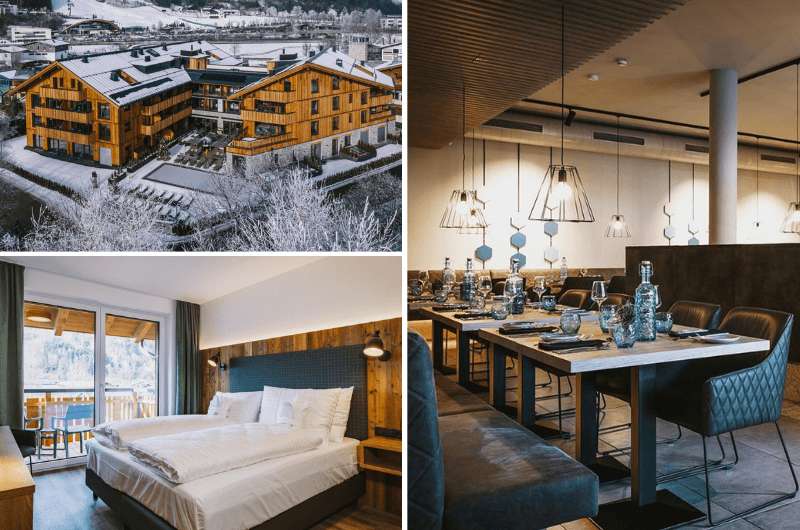
Your base in Zell am See: Elements Resort Zell am See; BW Signature Collection
But! Before you get to Zell am See, there’s still a ton to see.
Day 6, stop 1: Hohenwerfen Castle
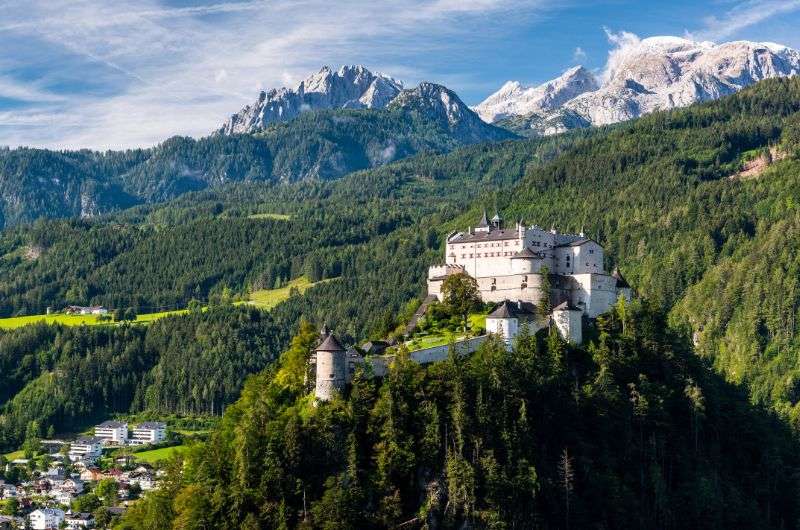
Hohenwerfen Castle
Time spent here: 1.5–3 hours, depending on the tour you choose
Hohenwerfen is one of the must-see places in Austria for people who love medieval architecture. This mighty fortress sits on top of the hill about an hour’s drive from Hallstatt, and you don’t need to worry about getting lost as you can see it from afar.
It’s an impressive structure in a beautiful location. Admittedly, the interior of the castle isn’t all that. What I enjoyed was the Mythos Jackl exhibition dedicated to witches’ and wizards’ history in Austria.
Mythos Jackl is an interactive presentation with 3D holographic prisoners and many other intriguing artifacts of this gruesome era in Austrian history. Apart from the real witch cases, we enjoyed the display dedicated to Germanic/Central-European myths and mythical creatures.
There is free parking under the hill right at the funicular station and at the beginning of the forest route leading to the castle. That’s in case you want to save EUR 3.50 for the short ride up and instead walk up to Hohenwerfen in about 20 minutes or so.
- Open daily except for Mondays from 9 am–anytime between 4 and 6 pm depending on the month
- Tickets for the full tour cost EUR 20.90, including the cable car.
Day 6, stop 2: Liechtenstein Gorge
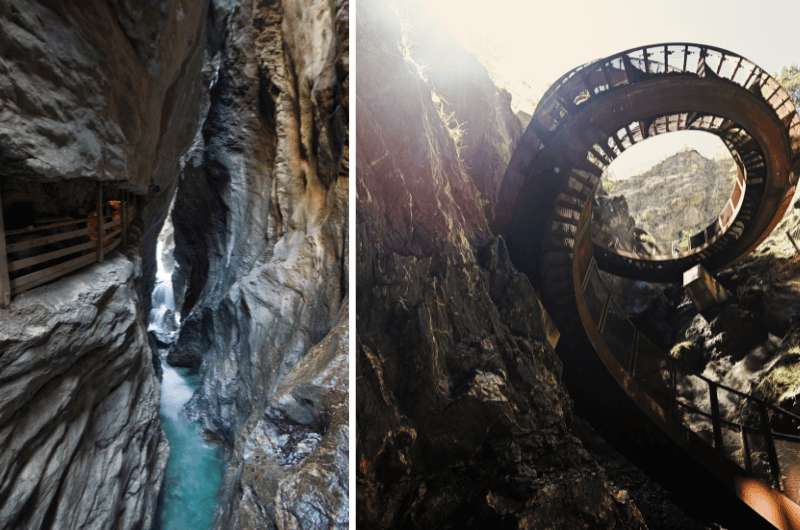
Liechtenstein Gorge
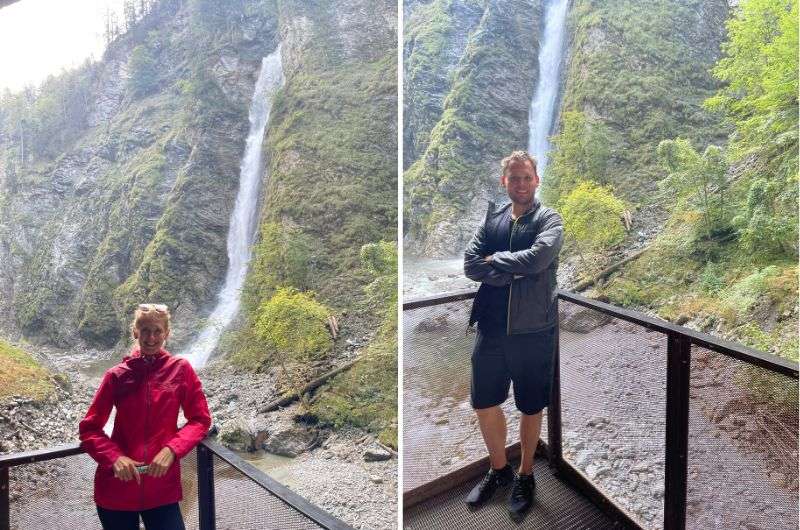
Enjoying the Liechtenstein Gorge, Austria
Time spent here: 2 hours
Liechtensteinklamm, aka Liechtenstein Gorge, is a gorge that you go into by walking down a huge spiral staircase,e and then, at the end of the walk (I wouldn’t call it a hike by any means), there is a waterfall. An enjoyable way to spend 1.5 hours in “civilized nature”.
If you visit in the summer season, be prepared to share this experience with tons of other tourists. If you visit in the winter, it’ll be closed (that is from November to the end of April).
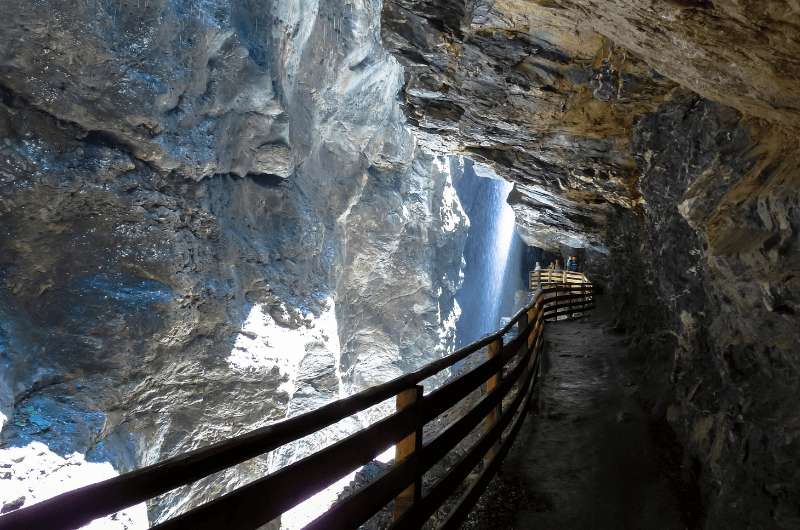
Liechtensteinklamm
The path through Liechtenstein Gorge is about 1.5 km (1 mile) long and is an out-and-back.
There is ample parking that is free of charge. It’s about 300 m (1000 ft) from the ticket desk of the gorge.
- Open daily May through end of October from 9 am to 6 pm (only until 4 pm in October).
- Tickets cost EUR 12.
Day 6, stop 3: Zell am See
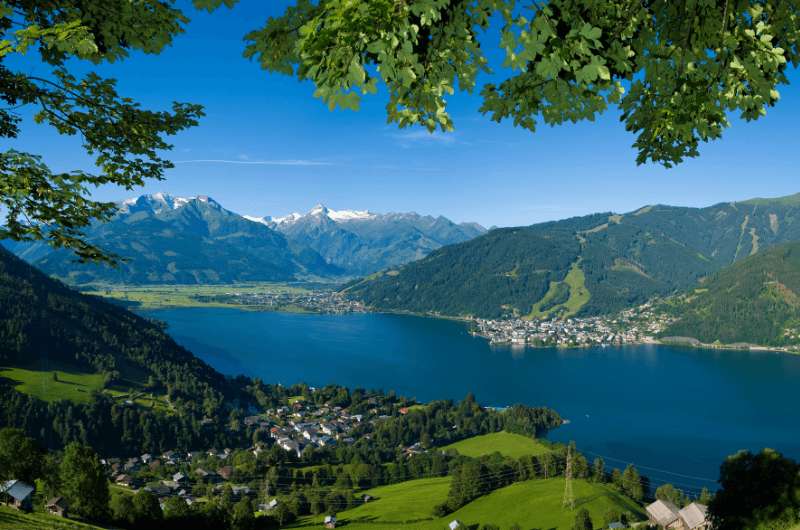
Zell Am See
Time spent here: the rest of the day
Last but not least, get yourself over to your base for the next night or two, Zell am See.
Long story short, it has a marvelous setting. Not only that the town itself adorable, but there are plenty of great places to see nearby. You’ll see what I mean in the next few days.
Zell is See’s Old Town is small, and there’s not much to see; however, the restaurants are good, and in the summer months, you can take a dip in the lake (the underwater springs make it warmer than you’d expect!).
There are literally just three sights in the town worth mentioning, but that’s ok since you’ve done enough touristing today already.
- The Rathaus (town hall), which resides in the former castle of the Rosenberg brothers—Schloss Rosenberg—was built in 1583.
- Vogtturm (Vogt tower) Stadtmuseum: The oldest building in the town, first mentioned in 926. Nowadays, there is a four-story museum of local history and culture together with geographical exhibits.
- The 13th-century parish church of St. Hyppolitus is richly decorated with original medieval frescoes.
Day 7 of Austria itinerary: Grossglockner
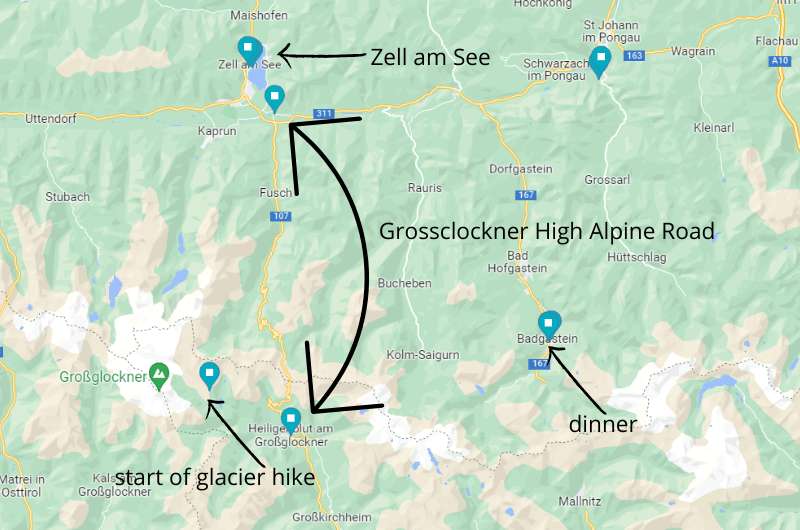
Today’s plan is clear: amazing views of the Alps!
Main sites visited on day 7: Grossglockner High Alpine Road, glacier hike, Zell Lake boat tour, Bad Gastein for dinner
Restaurant tips:La Pizzeria Napoletana | Gatz Tapas & Steaks | Moons Pub Gastein
Hotel recommendation: Elements Resort Zell am See; BW Signature Collection
Further reading: Best things to do in Zell am See | Best places in Austria
The main reason you’re staying in Zell am See is the gorgeous mountains all around. And today, you’re in for a special treat—Grossglockner, otherwise known as the most beautiful place in Austria (at least in my mind)!
Day 7—Grossglockner—stop 1: High Alpine Road
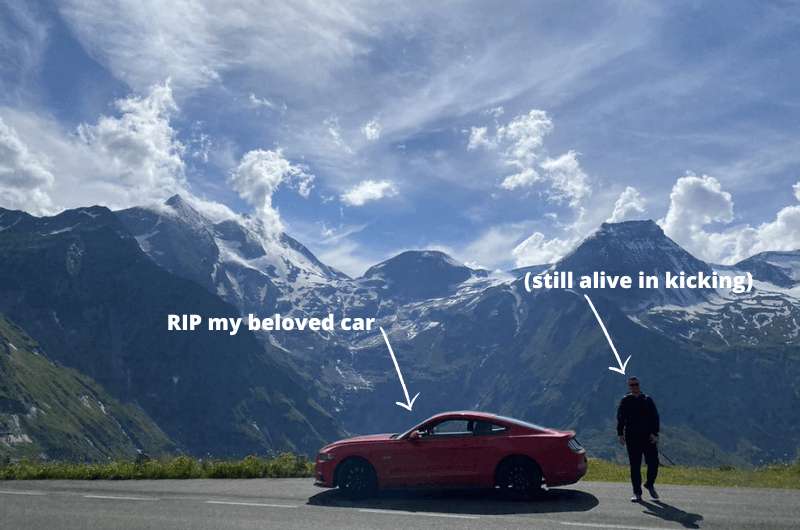
Those views, eh?
Time spent here: 1–2 hours
The Grossglockner is the highest mountain in Austria at 3,798 m (12,461 ft).
The High Alpine Road leads you through the mountain range at around 2,500 m (8,215 ft). For us, it was a whole-day trip, but it depends on how much you want to explore the surroundings.
The 48 km (30 mile) scenic route starts in Bruck an der Grossglocknerstrasse and leads to Heiligenblut. On the way, there are numerous parking lots with hiking trails leading to the most popular lakes and peaks. Or you can just stop for photos.
Beware the Großglockner Hochalpenstraße has opening times! Or rather it’s closed in the winter altogether, which is generally from November to the beginning of May. You can check if the road is open on the Großglockner Hochalpenstraße official website: www.grossglockner.at.
Tickets cost EUR 40 per vehicle.
Day 7—Grossglockner—stop 2: Glacier hike
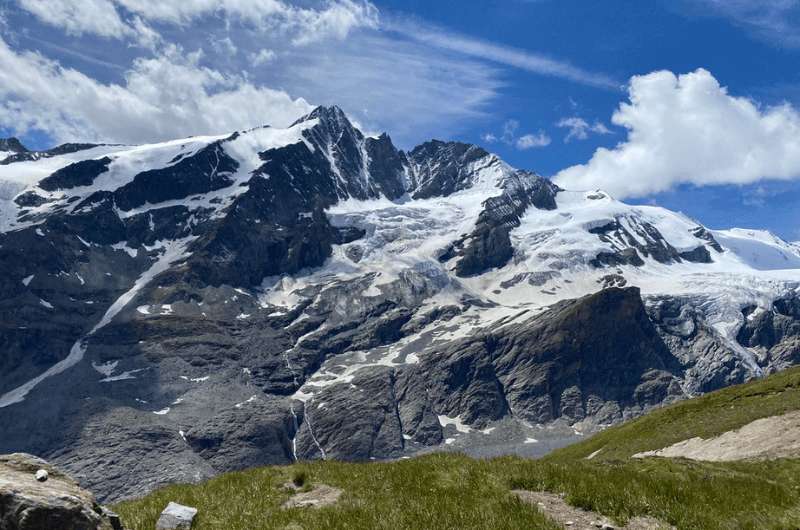
The Grossglockner Glacier hike
Time spent here: 3 hours
Now, it’s time to leave your vehicle and walk. You can choose any of the hikes, but this one to the glacier is one I think is the most badass. But it’s not for couch potatoes or those not ready to scramble!
Hike length: 6 km/3.7 miles (loop)
Hike duration: 2.5 hours
Elevation gain: 430 m/1400 ft
Difficulty: Hard
This hike will take you from Kaiser Franz Joseph Höhe to the Pasterze, the largest glacier in the Eastern Alps. It’s not long, but it’s quite hard just due to the trail being a little hard to follow, the steep descent at the beginning, and the rocks that you sometimes need to hold on to cables to get over safely.
Read reviews on Alltrails to find tips and even some recommendations on alternate (less crazy) routes, like taking the cable car part of the way.
You can easily park (for free) in what’s probably the most scenic parking garage I’ve ever seen. There’s also an information center there which could be useful when you’re deciding on a hiking route.
Day 7—Zell am See—stop 3: Lake Zell boat tour
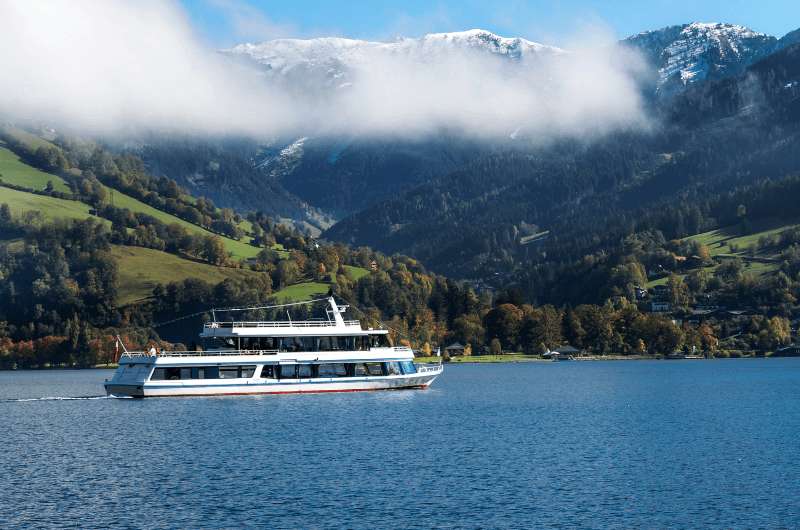
Lake Zell
Time spent here: 1 hour
You deserve a breather. But if you’re like me, you don’t just want to plop onto your hotel bed, you’d be missing all the amazingness out there!
So, I’ve got a better plan for you—rest, don’t move a muscle, and still explore while on a boat tour around Lake Zell. They do all the work for you, but you’re still out and about. Great, idea, right? I know; I’ll take a bow now.
Several ships tour the lake, so you can be certain there’s one leaving at almost any time you’re ready.
A boat tour will generally take about 45 minutes, the base price is EUR 17 for adults. On some boats, you can pay extra for a spot on the sun deck.
Day 7—Bad Gastein—stop 4: Dinner
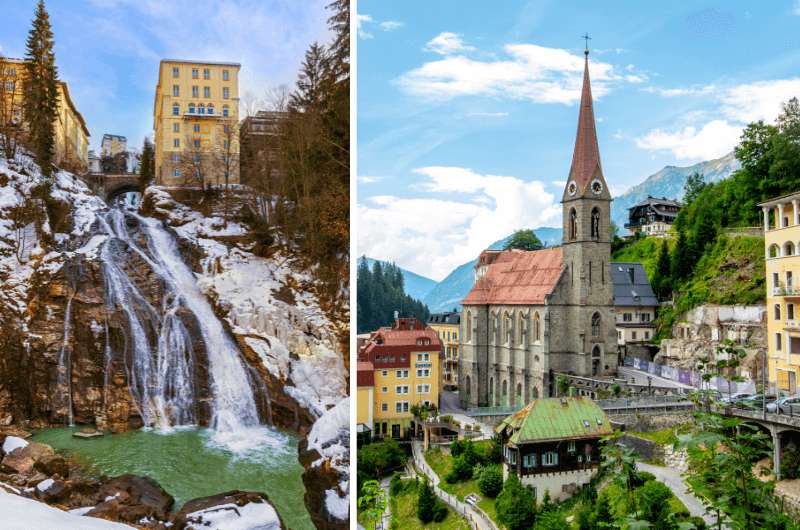
Bad Gastein. Yes, there are waterfalls in the city center.
Time spent here: 2 hours
Why Bad Gastein? Because this is the Alps, it’s only appropriate to have a meal in a town with a huge waterfall gushing down the middle of it!
The villas and hotels in Bad Gastein are built on the slopes of the mountains, partly hidden in the forest, but definitely not hidden from tourists—it's a popular ski resort in the winter and hiking/spa/forest bathing (you read that right) destination in the summer.
You’ll get a glimpse of this unique location with a [fill in dinner of choice here] stuffed in your mouth.
The obvious choice here is to find a restaurant right next to the waterfall. If pizza sounds good just about now, La Pizzeria Napoletana is probably the best option in town. That little terrace on the waterfall is a winner. If you don’t feel like pizza, at least stop by for an ice cream with a view (and possibly a spray, because the water is THAT close).
If you’re happy to swap the view for a big fat steak, head away from the falls to Gatz Tapas & Steaks.
And if you aren’t happy until you get a cocktail, Moons Pub Gastein has got you covered.
If you’re intrigued by Bad Gastein or rather its natural splendor, see what else I think is worth exploring in and around it in my article about my 7 favorite Austrian cities.
Day 8 of Austria itinerary: Kitzsteinhorn and around Kaprun
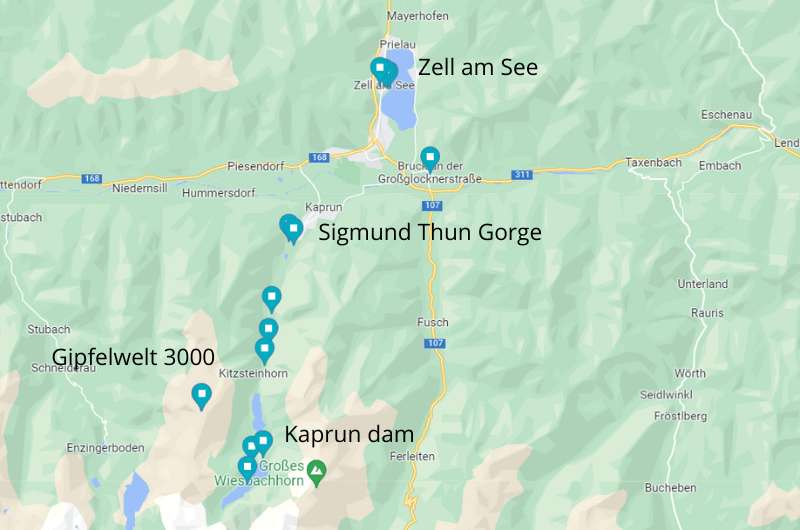
Day 8 of your Austria trip itinerary is another day full of natural highlights
Main sites visited on day 8: Sigmund Thun Gorge, Kitzsteinhorn and Gipfelwelt 3000, Kaprun dam
Restaurant tips: Gipfel Restaurant at Kitzsteinhorn | Bergrestaurant Mooserboden at Karpun Dam
Hotel recommendations: Elements Resort Zell am See; BW Signature Collection
Further reading: Best things to do in Zell am See | Best places in Austria
Day 8, stop 1: The Sigmund Thun Gorge Waterfall
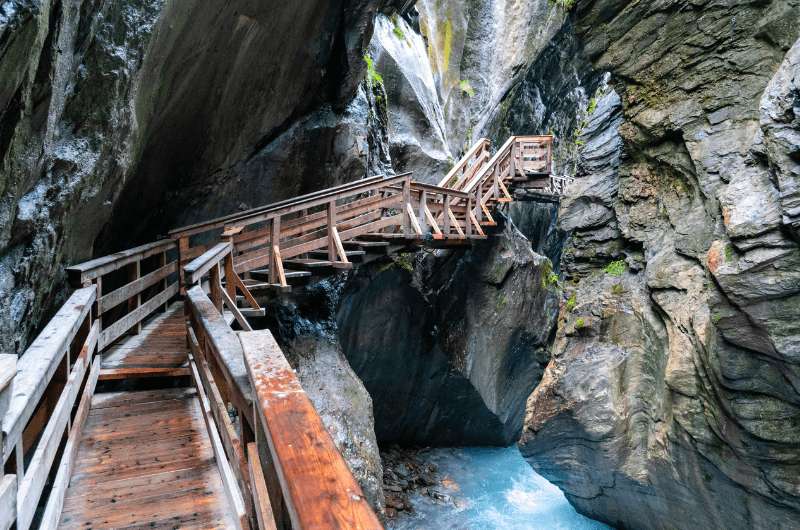
The Sigmund Thun Watefall
Time spent here: 2–3 hours
The Sigmund Thun Gorge (Sigmund Thun Klamm in German) is a wonderful world of narrow zig-zag paths and walkways through the cliffs where you can admire the crystal-clear waterfalls and moss-covered stones. Just look at the photos!
Take at least two hours to walk the route.
The roaring river forces its way through the valley, meandering and offering a magnificent view from the narrow and slippery boardwalks and bridges (proper footwear essential!). It kind of reminded me of the Hobbit barrel scene where the dwarves escape from the elves.
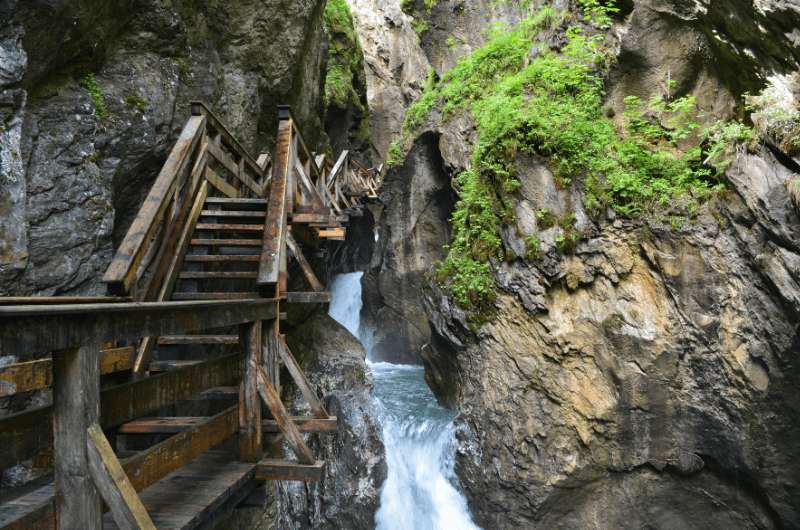
Don't slip up!
The parking lot is free of charge and is close to the visitor center.
- Open roughly between May and the end of October, daily from either 9 or 9:30 am to 5:30 or 7 pm
- Tickets cost EUR 6.50 for adults
Day 8, stop 2: Kitzsteinhorn and Gipfelwelt 3000
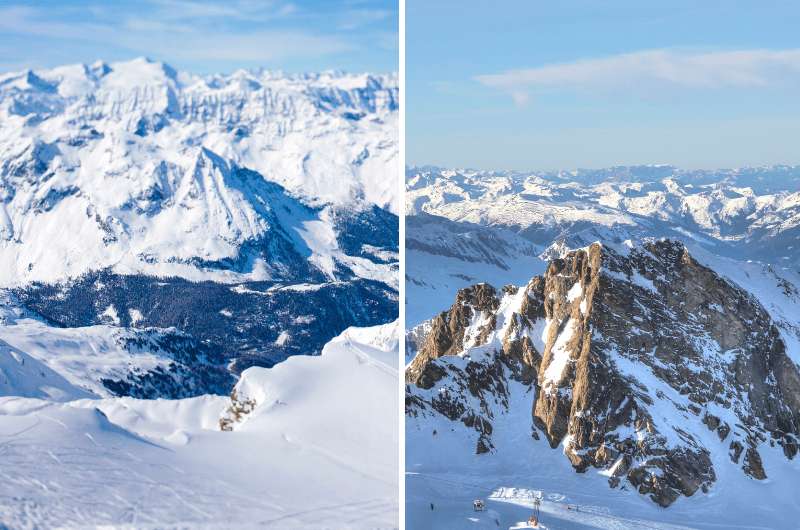
The views!
Time spent here: 2 hours
Another day, another glacier! Kitzsteinerhorn Mountain is at an altitude of 3,203 m (10,508 ft) and is a landmark of the Hohe Tauern National Park (just like Grossglockner).
The absolute top of the glacier is reserved for professional climbers, but there’s Gipfelwelt 3 000 Center at 3,029 m (9,880 ft) that has its arms wide open to tourists of all fitness levels. Even if you have a fitness level of zero, you can still come up here and stare out from the viewpoint and visit the Gipfel Restaurant and cinema. If you do have some stamina, go over to the Ice Arena.
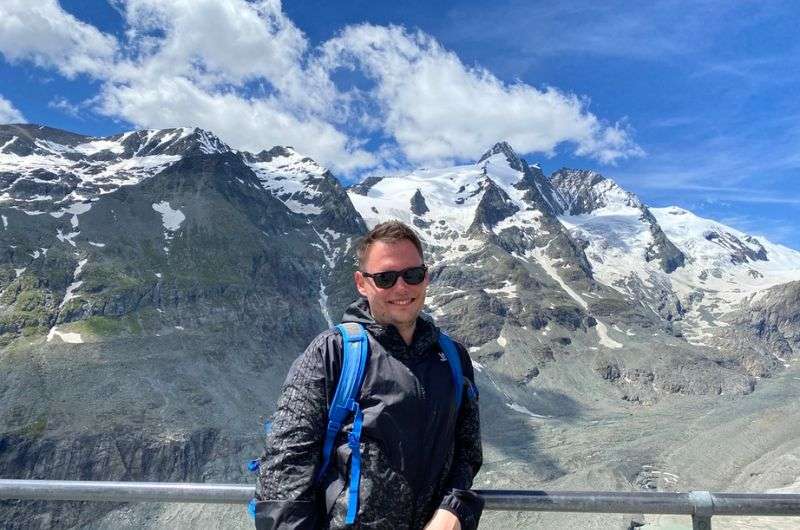
Me on the Top of Salzburg, Kitzsteinhorn
To get up to Kitzsteinhorn’s Gipfelwelt 3,000, you can take a hike up, but I’ll take a wild guess and give you the information for the cable car.
It’s not cheap, with up-and-down tickets at EUR 50 per adult, but hey, it’s pretty up there, and you’re too lazy to walk.
Leave your car at one of the spacious parking lots (free of charge), but be ready for it to be very busy if you wait until 10 am to get there.
Day 8, stop 2: Kaprun dam
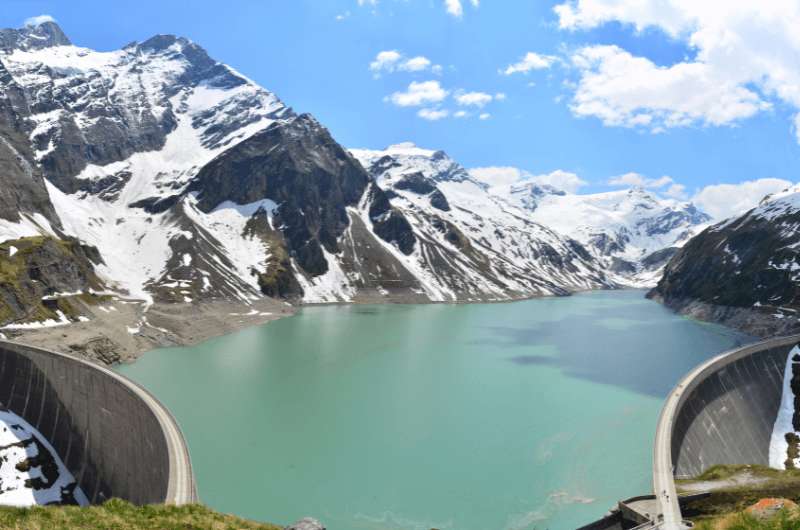
Kaprun dam
Time spent here: 2 hours
About 13 km (8.2 miles) further south of the Sigmund Thun Gorge lies the Kaprun Dam.
The technical marvel is at an altitude of around 2,000 m (6,500 ft) and provides electricity for the whole Zell am See-Kaprun region. The bonus is that it also looks fantastic!
There are two mountain reservoirs, a restaurant, and plenty of hiking options. Just be mindful of the rapid elevation gain (around 1,500 m/4,900 ft), which may cause trouble with breathing or dizziness.
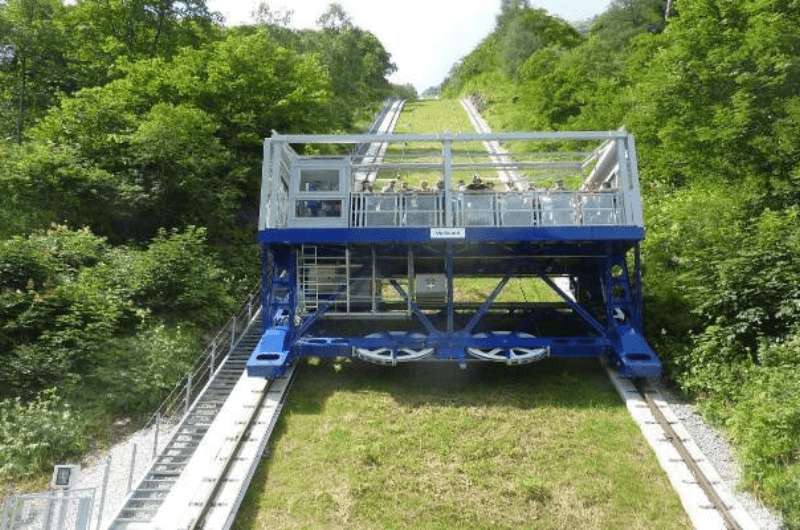
This monster truck of an elevator takes you up to the dam
Getting to Kaprun Dam is simple, but you need to board a bus. There are no cars allowed. Yikes!
Park your car by the ticket office, from which you will be taken by bus to a huge platform that creeps up the mountain, then you’ll be stuffed onto a crowded bus once again, and then you’ll have finally reached the reservoirs at the dam. The entire journey will take about 30 minutes and cost EUR 25.
The inclined elevator is an interesting experience by itself; the bus is more of a pain, but there’s no other way.
Or you could take a 2-hour hike. Up to you.
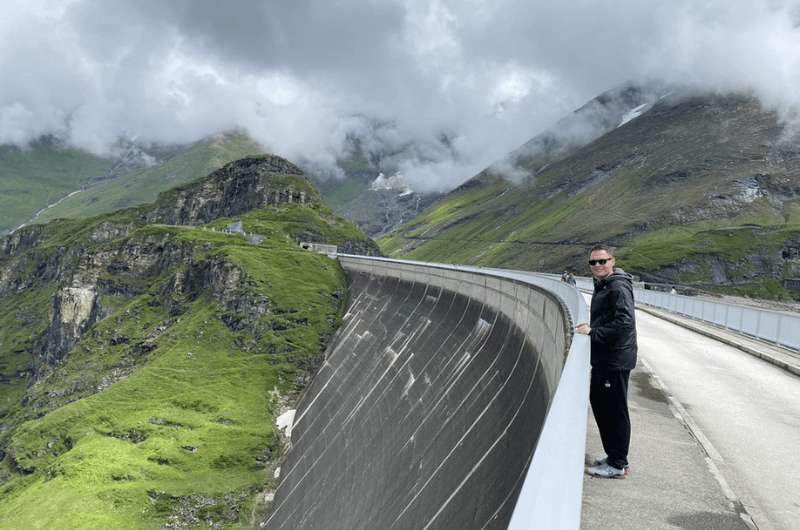
Taking in the views of the dam
If you are so inclined, make sure to also book a tour of the power plant when you’re buying your tickets (EUR 6).
There’s no exact timetable, but the buses leave continuously every 15 minutes or so throughout the day.
Once at the dam, you can choose to walk a 45-minute walk on the educational trail, and, whatever you do, make sure to reach the viewpoint.
Or, if you need adrenaline to feel alive, make it like Spiderman and climb the actual dam wall! The MOBO 107 via Ferrata will be an experience to remember.
Day 9 of Austria itinerary: Between Zell am See and Innsbruck
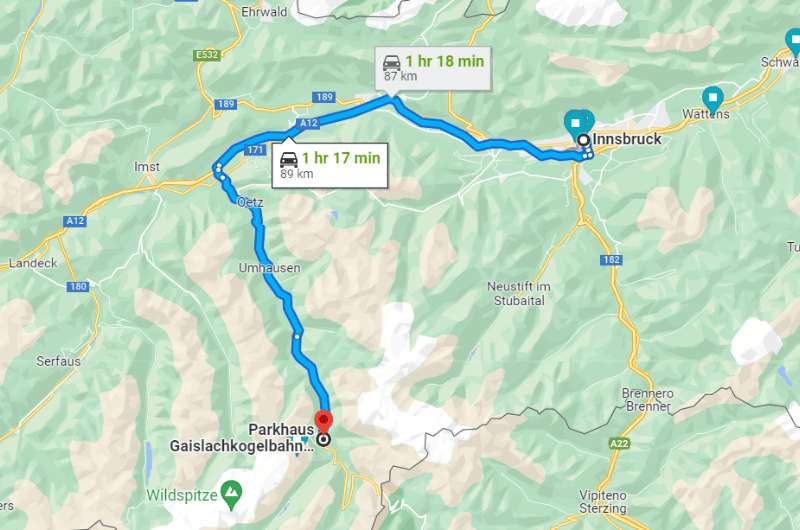
A map showing your drive from Zell am See to Innsbruck—your last stop on your 10-day Austria trip!
Main sites visited on day 9: Krimml Waterfalls, Schwaz Silver Mines, Swarovski Kristallwelten, Innsbruck
Restaurant tips: Gaia Cuisine | Akropolis | Woodfire Steak&More (all in Innsbruck)
Hotel recommendations: Hotel Innsbruck (book for 1–2 nights)
Further reading: What to see in Innsbruck
Your final destination today is Innsbruck, but you’ll be making a couple of stops on the way to break up the 2.5-hour drive in some pretty spectacular spots. Think waterfalls, silver mines, and a crystal world.
Day 9, stop 1: Krimml Waterfalls
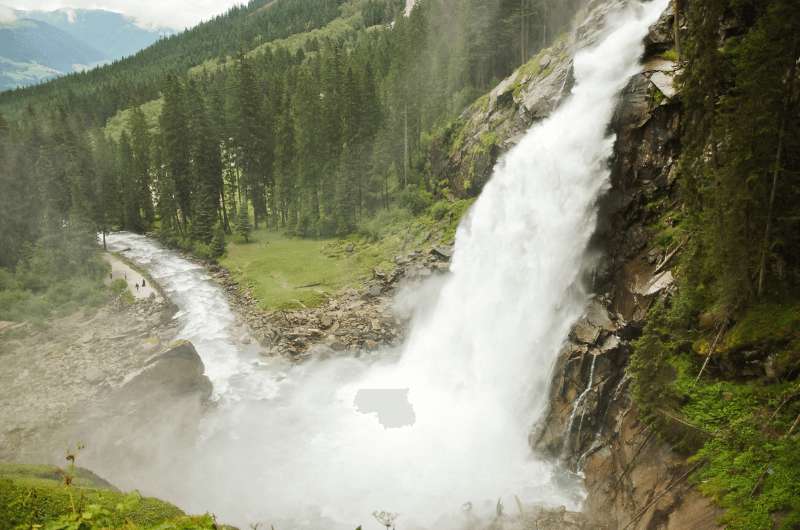
Krimml Waterfalls
Time spent there: 2.5 hours
The first stop, at about the halfway point in the journey to Innsbruck, is none other than Europe’s tallest waterfalls—Krimml Waterfalls (Krimmler Wasserfälle).
Walk the 4 km (2.5 miles) long trail with many viewpoints and platforms leading you up to the top through the Krimml Ache Valley along the numerous waterfalls. The overall altitude gain is 431 m (1,414 ft), and the trail takes about two hours up and down. You reach the first waterfall in about 15 minutes.
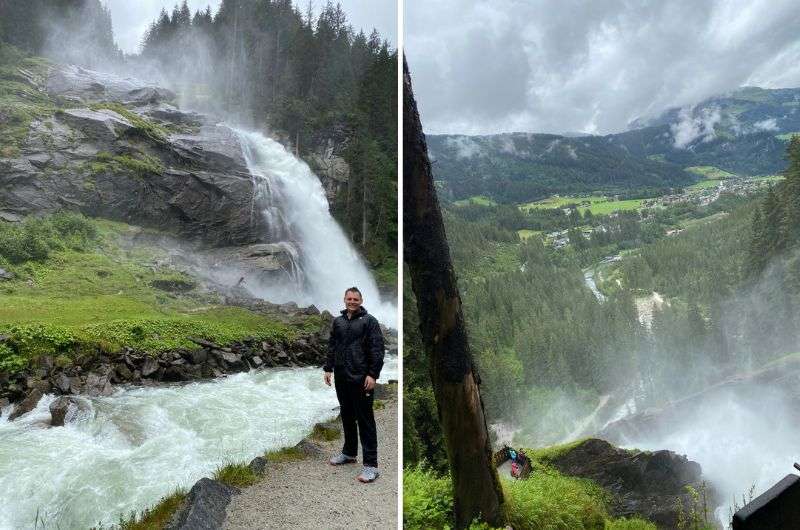
Krimml Waterfalls
There are several parking lots near the town by the falls, so you should be able to find a spot even on the busiest days. Parking is—you guessed it—free.
Get your tickets at the ticket desk, along with souvenirs, maps, and even food.
- Krimml Waterfalls are open daily from mid-April to the end of October.
- Tickets cost EUR 8 for adults.
Day 9, stop 2: Schwaz Silver Mine
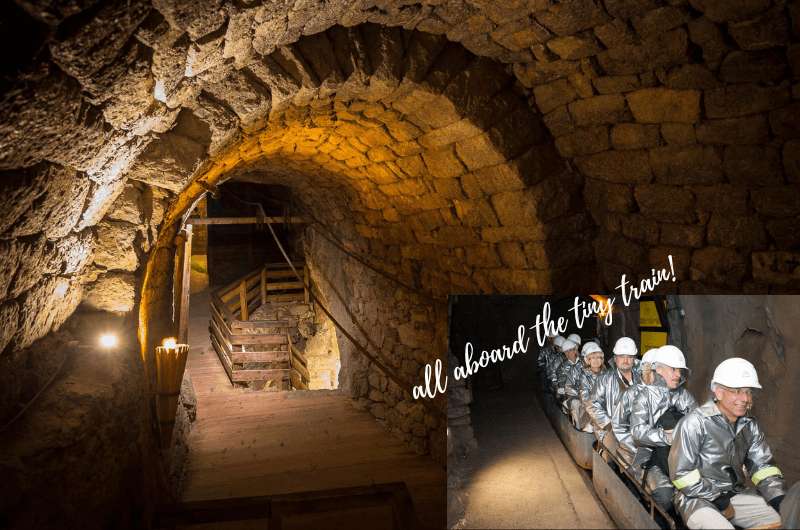
First, you board the train, then you walk through the mines
Time spent here: 1.5 hours
After another hour’s worth of driving and you arrive at the Schwaz Silver Mines, a big deal of a place where you can discover how they mined silver and copper 500 years ago. It wasn’t just a random mine—it was where 85% of the silver in the Middle Ages came from!
The tour starts and ends with a ride on a little miners’ train, so no need to walk in and out of the depth of 800 m (2,600 ft). It feels like a claustrophobic Disneyland ride in the dark.
You’ll get a raincoat and hard hat before you enter, but make sure you also have some warm clothes on and some proper shoes. The temperature below is 12°C (53°F), and it’s wet and slippery in parts.
Once you leave the train, you walk around with a German-speaking guide for about an hour. If you nicht sprechen Deutsch, you can download their app for English explanations, but definitely bring headphones.
The guides are great, but the ladies at the ticket desk can be a bit of a mood-buster. You can avoid dealing with them if you book your ticket online.
Overall, I would’ve loved more details on the technology back then, but maybe that’s just me. If you have 1.5 hours to spend walking around in a damp underground tunnel, go for it.
There’s a silver shop where you can get something for your grandma back home.
Tours keep going throughout the day based on how many people are interested, so you might have to wait a while either because there are too many people or not enough people.
- Open daily 9 am–5 pm from May to September, 10 am–4 pm in other months. Tours leave every 30 to 60 minutes throughout the day.
- Tickets cost EUR 18 (or EUR 20 online)
Day 9, stop 3: Swarovski Kristallwelten
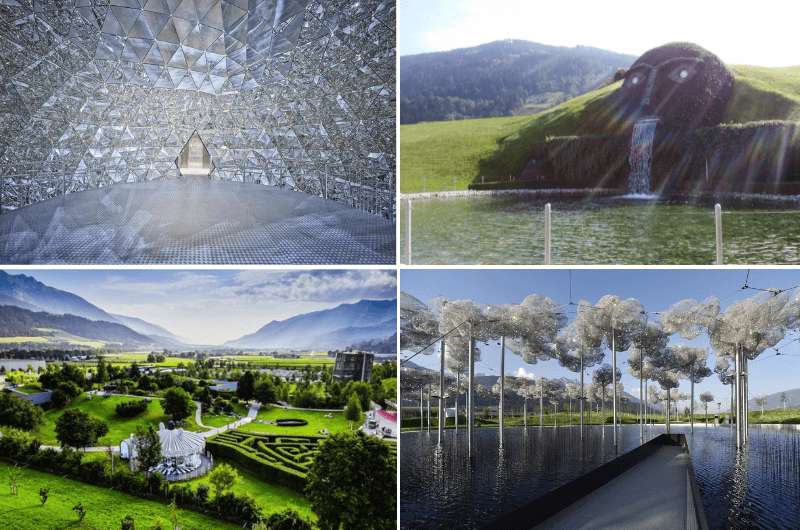
The magical land of Swarovski Kristallwelten
Time spent there: 2 hours minimum
Experiencing this Swarovski wonderland is like taking Alice in Wonderland and bringing her up!
This place is a stark contrast to the silver mines you just visited. Everything is beautiful, magical, mesmerizing, and clean! No damp tunnels at the Swarovski Kristallwelten!
So what is this place? Yes, it’s a big Swarovski store, but it’s also an indoor and outdoor exhibition space that any fancy man or woman will enjoy and leave with a twinkle in their eye.
The gardens and the 18 Chambers of Wonder were put together by internationally recognized artists and architects. The centerpiece is the Giant spitting out water, but you can also hop on a carousel if your head is spinning from all the glitz and you need to sit down for a bit. Wait, that won’t help...
Obviously, there are crystals everywhere, and I dare you to leave without buying yourself something shiny.
Parking is free of charge. Audio guides are available in many languages. Get your tickets online to avoid lines at the ticket desk (especially if visiting on a weekend).
- Open daily 9 am–6 pm
- Tickets cost EUR 24 + EUR 2 for the audio guide
Day 9, stop 4: Innsbruck
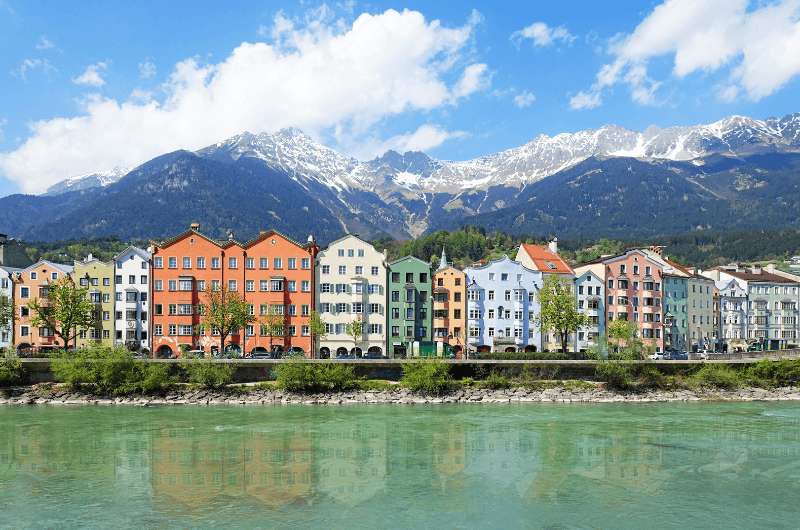
Mariahilfestrasse with the famous colorful houses and the Alps in the background
After getting your bling on at Swarovski, you’re just a 15-minute drive to your last overnight stop on this 10-day Austria itinerary: Innsbruck, also known as my second favorite city in Austria.
After the long day you’ve had, especially if you managed to visit every spot I recommended, you’re probably ready to call it a day and hit the hotel bar. OR, get naked and hit the rooftops!
Let me explain:
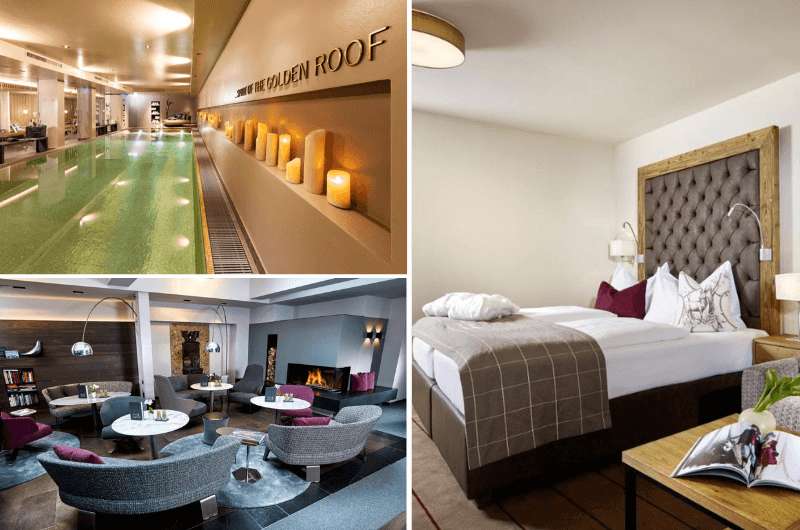
The hotel we stayed at: Hotel Innsbruck
Hotel Innsbruck, which is where I stayed and would stay again, has a nude area in its Panorama Wellness with huge windows and even a sun terrace with views over the roofs of Innsbruck’s Old Town. So throw away your worries and your undies and take your first peek at Innsbruck in your birthday suit!
The only slight nuisance here is that unless you grab a reservation for the limited parking spots in the hotel garage, you need to park in the public parking garages. Granted, they’re only 3 minutes away on foot, but I thought I’d mention it so you aren’t surprised. You can unload your luggage at the hotel before heading to the garage.
Otherwise, Hotel Innsbruck was the perfect spot to explore the city.
Exploring Innsbruck’s Old Town
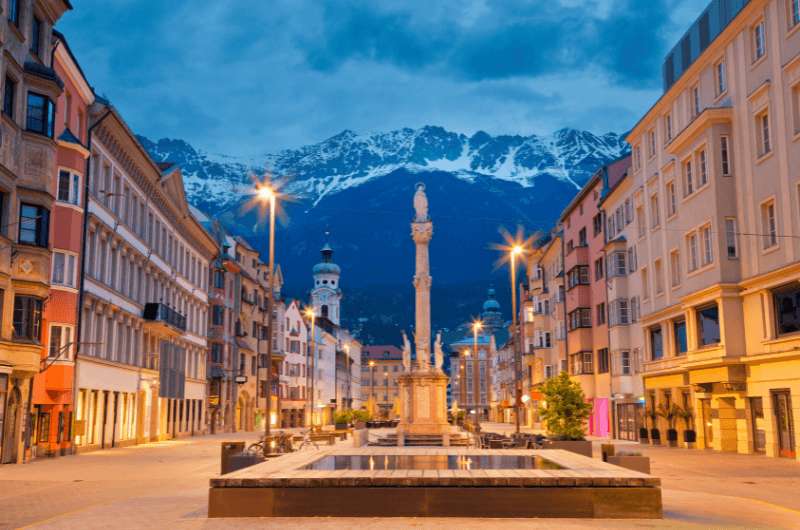
Innsbruck’s Old Town
If you’re the type that tirelessly explores every destination and you don’t want to give up on the day just yet, take a stroll through Old Town, either before or after your evening in Hotel Innsbruck’s amazing spa and pool area.
Check out my article dedicated to all things Innsbruck to read up on what there is to see. The Stadtturm (tower) is right around the corner from the hotel, as is the Golden Roof. And also a Swarovski store, just in case you’re wondering if you should’ve bought that other necklace at Swarovski Kristallwelten.
I love Innsbruck because there isn't stupid Baroque everywhere. The streets of Innsbruck's Old Town are filled with medieval houses and surrounded by majestic alpine landscapes, and that’s something hard to beat.
Across the river from the Old Town lies Mariahilfestrasse with the famous colorful houses. The photo of the houses clutched between the River Inn and the mountains is a must-have in Innsbruck.
Day 10 of the Austria itinerary: James Bond Museum
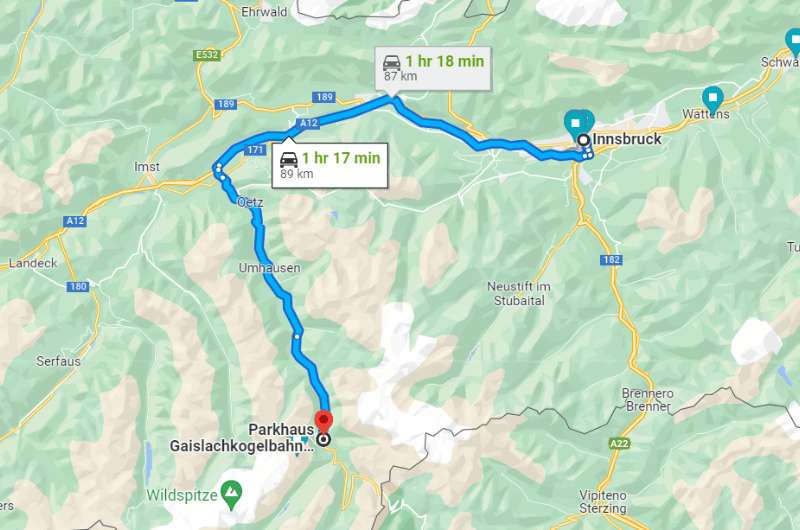
This is the route from Innsbruck to the parking lot for 007 Elements
Main sites visited on day 10: 007 Elements (Museum of James Bond)
Restaurant tips: Restaurant Ice Q | Restaurant Ad Vinum
Hotel recommendations: Depends if you’re staying another night in Innsbruck or are heading back to Vienna
Further reading: Know Before You Go: Austria
Day 10, stop 1: 007 Elements (Museum of James Bond)
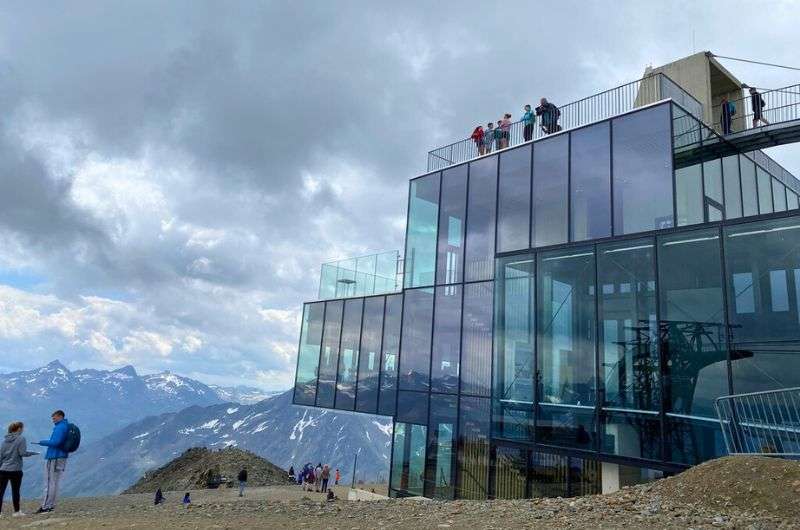
007 Elements James Bond Museum
Time spent here: 3 hours plus time for lunch
It’s the last day on this Austria itinerary, and you’ll be heading out even further from Vienna! Sound like an excruciating drive back to the capital? You’re right! But it’s a high-tech James Bond museum inside a mountain summit—you can and will do this!
Drive a little less than 1.5 hours from Innsbruck to Sölden and visit the James Bond Museum called 007 Elements. You leave your car at the parking garage at the base of Gaislachkogl Mountain and then take the gondola up the mountain.
You’ve surely bought your combination ticket online in advance, so you already have your ride up and down paid for. Just make sure to allow 30 minutes for the gondola ride so you get to 007 Elements in your time slot.
The cinematic installation takes you through the major moments of James Bond movies, with special emphasis on Spectre, which was shot at Sölden.
It might sound random, but it’s a must-see stop for fans of classy cars and badass agents. You will see how the tricks in the movie were done, an exhibition dedicated to action scenes, the hall of James Bond’s legacy, and more in a total of 9 exhibition rooms. All are superbly well done; it really is a cool place. You’ll need 2 hours to enjoy everything.
When you’re ready for lunch, head to the on-site Restaurant Ice Q. The food is delicious, the view is breathtaking... and so is the bill.
- Open daily
- The combination ticket (museum + gondola) costs EUR 54
If you’re heading back to Vienna today, get ready for the 6-hour minimum drive if you’re going from Sölden. If you have extra time, just stay another night in Hotel Innsbruck so you have more time to explore this amazing Alpine city and shorten your drive to the capital to a doable 5 hours.
Driving in Austria: What is it like?
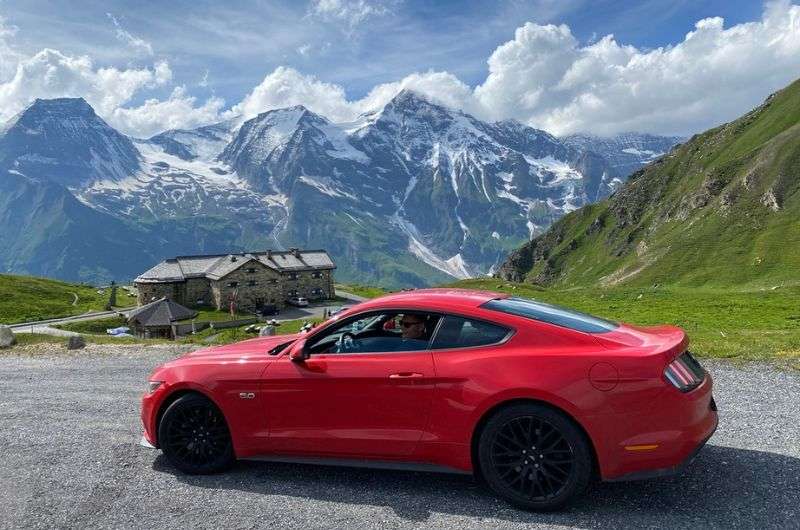
Get yourself a vehicle that brings you joy
While it may pay off to travel by public transport in the big cities (especially if you have a city card), it can turn into a nightmare in the country areas. The best way to travel around Austria is by renting a car.
The views are breathtaking and if you have a car, you can easily see the whole of Austria in just a few days. That is particularly relevant in the mountain areas, where it might be complicated to travel by public transport. However…
Driving in Austria can be a nightmare. Not that the roads aren’t in good condition or anything—they are. Even the signs are well-posted. But I’ve been driving in South Africa, and it was much more disciplined there!
Austrian drivers are madmen and are always driving in the left lane even though they know it is for overtaking. However, to my big surprise, they do respect the speed limit (which I tend to forget about sometimes).
What are the speed limits in Austria?
- In towns: 50 km/h (31 mph)
- Country roads: 100 km/h (62 mph)
- Highways: 130 km/h (80 mph)
Also, remember that in Austria, they drive on the right side, and wearing a seatbelt is required by law.
Is 10 days enough for Austria?
Yes, 10 days is enough to cover Vienna, Salzburg, Hallstatt, Innsbruck, and a bit of the Alps without rushing. You won’t see everything, but you’ll hit the highlights. Remember, the best things to see in Austria are natural: the mountains, the gorges, and the unbelievably beautiful scenery.
Which month is best to visit Austria?
The best months to visit Austria depend on what you’re after:
- Spring (April–June): Fewer crowds, pleasant weather, and nature waking up from its winter coma.
- Summer (July–August): Great for hiking in the Alps. In cities, this will be the most crowded time with the most expensive hotel prices.
- Fall (September–October): Crisp air, fewer tourists, but also some grey, drizzly days, especially in the mountains.
- Winter (December–February): Ski season is in full swing! Plus, Austria’s Christmas markets are next-level cozy.
Verdict? Late spring or early fall are the best times for sightseeing and enjoying sunny times in nature.
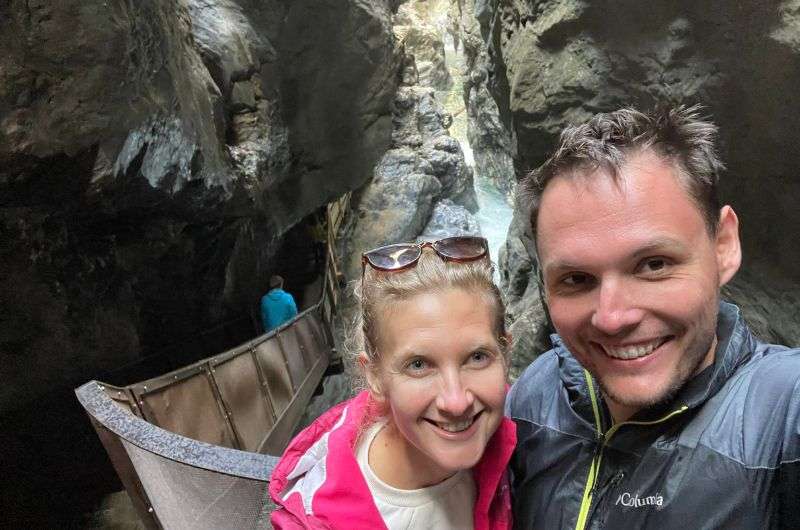
We're on our way, now it's your turn @ Liechtenstein Gorge
What is the nicest city in Austria?
I’ve got a top 3 for you:
1. Hallstatt: A tiny lakeside village with a ridiculous amount of history. It’s the kind of place where you can breathe in 7,000 years of civilization while staring at a picture-perfect lake. Overrun by tourists? Yes. Worth it? Also yes.
2. Innsbruck: The Alpine capital, where you can stand in the middle of a city and still feel like you’re in a mountain village. It’s the perfect base for hiking, but there is plenty to do in its charming medieval old town, too. Wonderful.
3. Salzburg: Mozart’s birthplace still looks like it did centuries ago. Admittedly not my favorite city because I have enough Baroque architecture from my hometown of Prague. But for everyone else, apparently , the Baroque palaces and residents and the huge cathedral are worth a visit.
And then there’s Vienna, my frenemy. I started off yawning through it because honestly, it’s just so blah—grand buildings, fancy coffee houses, but not much excitement. Then, after a few visits, it started growing on me. Now, I kind of get why people love it. Still not my favorite, but I’ve made peace with it.
You might also be interested in reading:
- 3 Days in Vienna: The Ultimate Itinerary
- What is Austria Known For? 13 Tips and Tricks for Your Vacation
- 9 Unusual Things to do in Vienna
- 7 Top Tourist Cities in Austria: Highlights, Trips, Hotels, and More
This post contains affiliate links. I earn a small commission if you make bookings through my links at no additional cost to you. Thank you for your support!


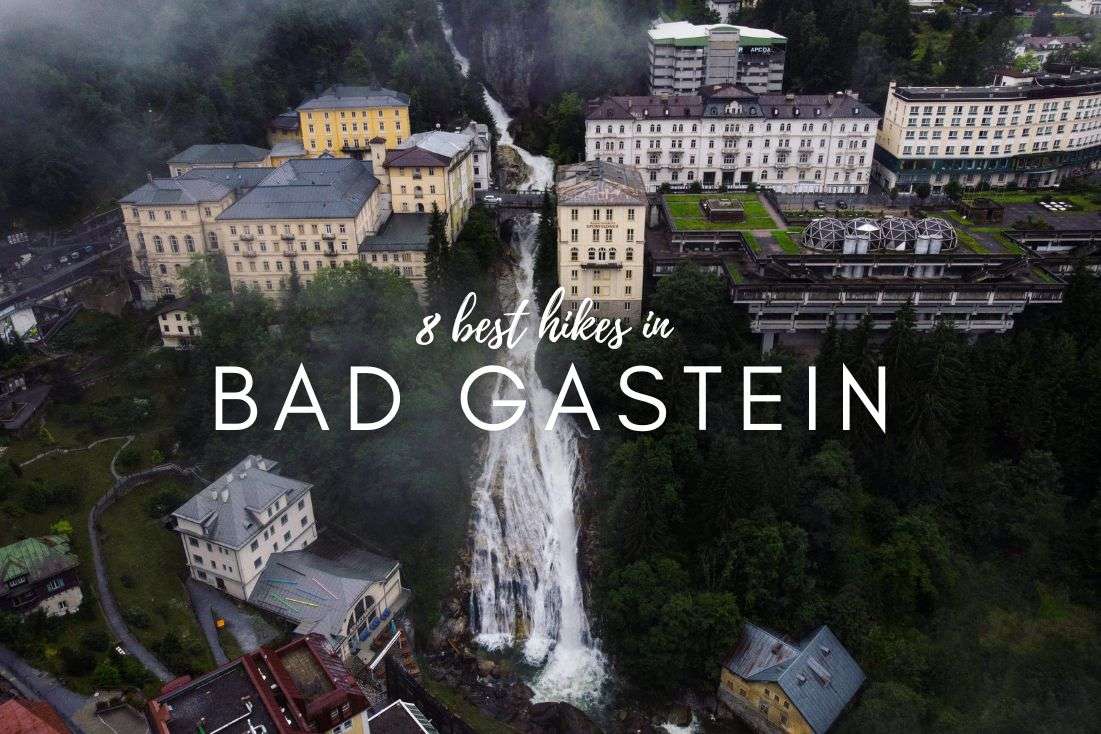
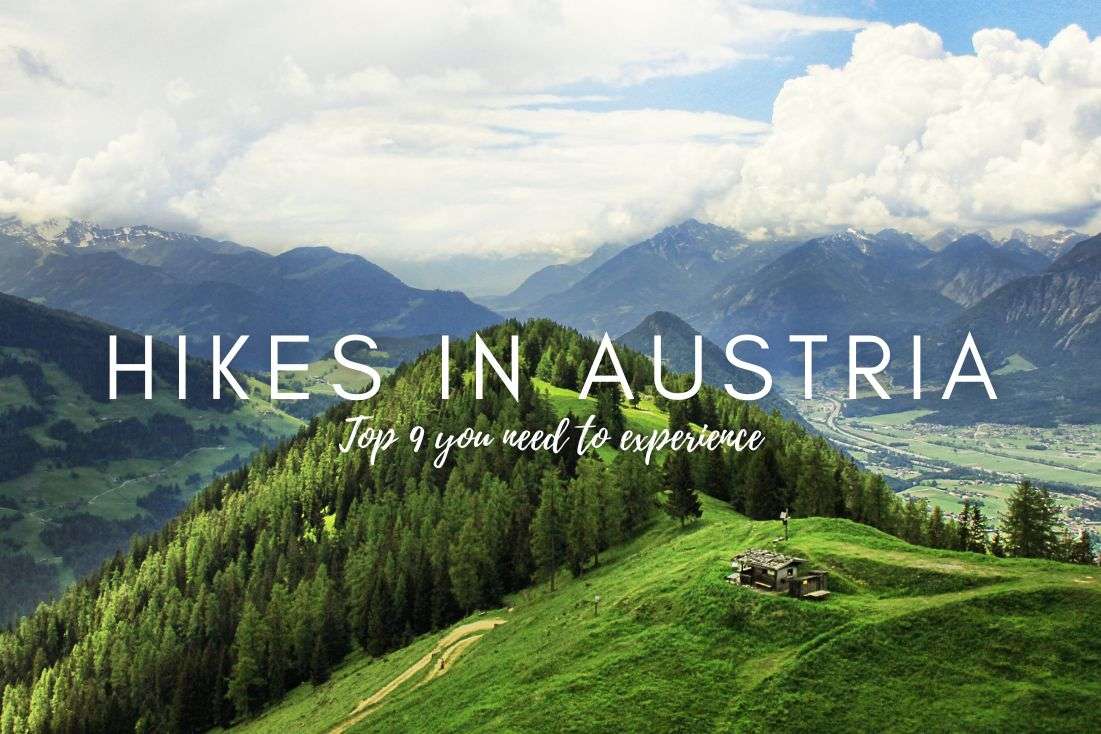
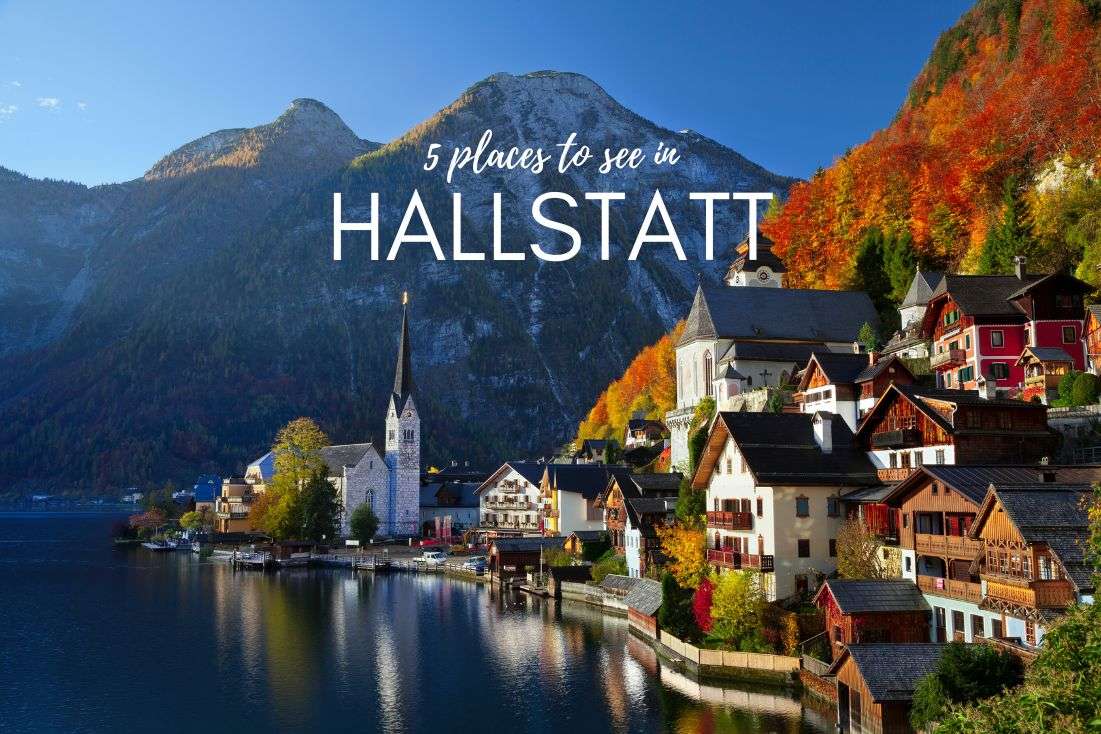





Comments | Thoughts? Give us a shout!